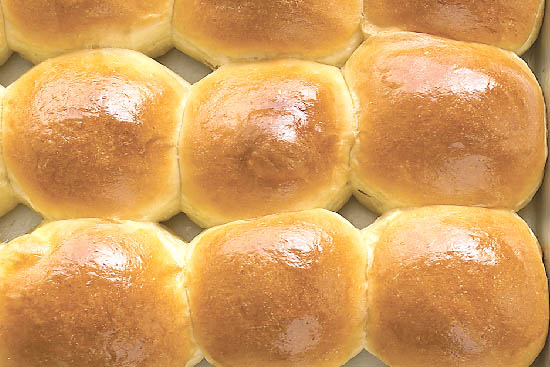48 recipes
Air buns
Amaretto fruit bread
Amritsari kulcha
Apple and oat scones with cinnamon
Best homemade dinner rolls
Blueberry corn bread
Blueberry scones
Brioches
Caramelized onion biscuits
Challah bread
Ciabatta bread
Cinnamon apple stuffed challah
Cinnamon rolls
Corn bread
Corn bread with sun dried tomatoes
Cramique brioche
Croissants
Crumpets
Cuchaule - saffron bread recipe
Double cranberry soda bread
Dutch baby apple pancake
English muffins
Ethiopian injera pancake
Fast focaccia
Fougasse bread
Greenlandic cake
Hokkaido brioche
Homemade pizza dough
Irish soda bread
Khachapuri cheese bread
Lavash
Malaysian flatbread-roti canai
Malt bread with raisins
Morning glory muffins
Naan
Onion braid
Parker house rolls
Pogne de romans
Quick and easy pancakes
Roman maritozzi
Rye bread rugbrod
Skyr bagels
Spiced pita chips
Spicy cheese corn bread
Streusel pumpkin bread
Whole grain brown soda bread
Whole grain soda bread
whole wheat irish soda bread with bulgur
Weight & temperature Measures
non-liquid ingredients
Top 5 countries
Last Page
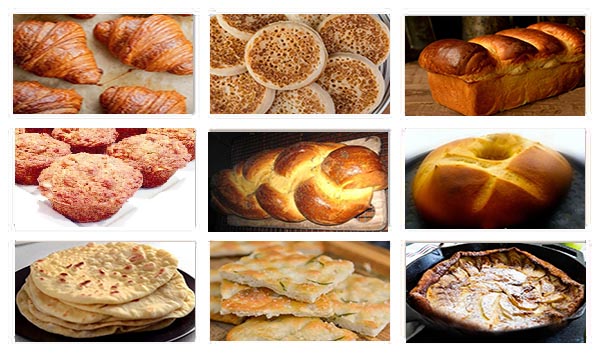
Baguette
A baguette is a yeast bread that originated in France. This bread has a characteristic long, oblong shape with slits in it. These slits allow for the expansion of gas while the bread is baking. Also called French bread or French sticks, baguettes are typically made from flour, water, yeast, and salt, and their look is easily recognizable to bread lovers all over the world.
Brioche Bread
A French bread made with butter and eggs, brioche is extremely light in texture and has a subtle sweetness in its flavor. Brioche crust is soft, appearing to have a golden-yellow shade. This gorgeous golden color can be attributed to the egg that is brushed on top of the dough before the bread is placed in an oven to bake. Brioche bread is a perfect bread choice, especially when making delicious treats like French toast. If you’ve never tasted this type of bread before, there is no better time than right now to grab a loaf of soft, slightly sweet brioche.
Ciabatta Bread
“Ciabatta” is the Italian word for “slipper.” This Italian-invented bread is made from a few basic ingredients, which include water, salt, yeast, and wheat flour. Depending on where in Italy you are eating ciabatta bread, its crust and even its texture can vary. However, the main ingredients in making ciabatta bread are the exact same in every loaf. Ciabatta is perfect for use in making paninis and sandwiches, as well as many other dishes, and has a chewy crust and soft interior.
Focaccia Bread
This type of bread also originated in Italy. Focaccia bread is usually placed in a baking pan so that it results in a flat loaf. Focaccia dough is quite similar to pizza dough, and is usually coated with olive oil before baking. The crust of focaccia bread comes out crunchy, yet delicate and thin. Many bakers add herbs and garlic to the recipe as desired, and sea salt is another popular addition. Focaccia bread can be eaten by itself, dipped in soup, or used to clean a plate of leftover sauce.
Multigrain Bread
With its rich, hearty flavor, multigrain bread usually uses grains such as oats, barley, flax, and millet, as well as others. The use of these different ingredients makes multigrain bread an extremely healthy and delicious bread choice. Multigrain bread is perfect for use in morning toast, sandwiches, or to dip in dressings or vegetable oil that has been sprinkled with herbs.
Pita Bread
There are a lot of things munchers can do when eating a piece of pita bread. This includes dipping the pita into sauces after it is cut it into wedges, or filling it with various types of meats for a tasty and delicious sandwich. Pita bread originated in the Middle East and is cooked at very high temperatures, which makes the liquid in the dough escape quickly. This helps to create a large air bubble in the center – the “pocket” of the bread – perfect for stuffing with meat and other foods. Pita bread is made mostly using wheat flour.
Rye Bread
Long considered to be the bread of the lower class, rye has gained a surge in popularity, likely due to its rich flavor. Made with both rye flour and regular bread flour, rye bread has a tight crumb and a very strong flavor. Some bakers even add caraway seeds or dill seeds so that the rye bread flavor is a little more earthy. In certain sandwiches – most notably, corned-beef and pastrami sandwiches – rye bread is what gives the sandwich the signature taste that people love about them. Adding a touch of mustard on a slice of bread used in these sandwiches can help accent the flavors of the bread and meats, as well.
Sourdough Bread
In a loaf of sourdough bread, a starter is used before making the dough to create the basis for the dough. The sourdough starter usually consists of a fermented combination of water and flour, which in turn can make many batches of bread. Another advantage of this type of bread is that the sourdough starter can last a long time. The length of the life of a sourdough starter means that bakers can make loaf after loaf of sourdough bread without worrying about running out of the starter. Sourdough bread has a thick crust and a soft chewy center, and is dotted with very large air bubbles inside. It also has a distinct taste that can be almost addicting. Sourdough bread can be used to make any type of sandwich for a mild and delicious bread option.
Whole Wheat Bread
In making white bread, only parts of the wheat grain are used. However, when it comes to whole wheat bread the germ and the bran are intact. What does this mean for those eating this bread? It means whole wheat bread is more nutritious and has much more fiber than white bread does. Whole wheat bread can be used in making any type of sandwich where white bread would typically be used. It’s easy to create one’s own whole wheat bread recipes with a little creativity. Unique Types and Specialty Breads
Arepa Bread
Mostly eaten in Colombia and Venezuela, arepa bread is made from cornmeal. This flat and round break can be baked, grilled, or fried. Bakers can even include various fillings such as ground beef and black beans when making this bread. Since arepa is not made with wheat, it is naturally gluten-free, making arepa bread an excellent choice for those with celiac disease or who are gluten-sensitive.
Bagels
Bagels are usually made by boiling the dough in water for a short time then baking it afterward. They are round and come in two parts, with a hole in the center. The best thing about bagels is their numerous types and flavors. Some flavors include egg, cinnamon, and blueberry, among others. Try eating a bagel in a traditional way, adding salmon or cream cheese, or both, and immediately fall in love.
Chapati Bread
A popular Indian flatbread, chapati bread is usually grilled until it gains a freckled appearance. You can eat this type of bread with vegetables or lentils, or even make a sandwich with it. Chapati bread is usually made with whole-wheat flour and cooked with no oil. Snackers can even add a little butter to chapati bread to make it a touch more flavorful.
Damper Bread
Originating in Australia, this type of bread consists of flour, water, salt, and sometimes milk. Damper bread is usually eaten alongside stew or meat. At one time, damper bread was cooked over an open campfire. This type of bread is tasty and versatile. Add baking soda to the dough as leavening, if you so desire.
English Muffins
These are small, round, flat types of bread that can be made from either white or whole wheat flour. You can eat English muffins with poached eggs, bacon, or a Hollandaise sauce. More often than not, English muffins are healthier than many other options, like muffins or bread. However, the American version of the English muffin is slightly different from the original English muffins, so a little research might be in order when baking these breakfast treats.
Grissini Bread
Somewhat similar to breadsticks, grissini is a crisp, dry bread that appears as thin sticks that resemble a pencil. Native to Italy, this type of bread can be flavored in any way that the baker wants. So, feel free to add herbs and spices of any type to liven up its flavor. Grissini bread is mostly used as a before-dinner alternative to regular or garlic bread, but it can be eaten any way you wish, as well.
Injera Bread
This is a sourdough type of bread with a spongy texture and a slightly sour taste. Injera bread is typically made from a tiny grain called teff, which comes from Ethiopia. Injera bread is used to scoop up the meats and stews that are normally placed on top of it, and that are essential and typical parts of the Ethiopian diet.
Knäckebröd Bread
This bread looks more like a cracker than the traditional appearance of bread, and it is made mostly of rye flour. Knackebrod contains a lot of fiber, and can be served with cheese or any other type of food you love. This type of bread is dry and stiff, and appears rectangular in shape like many crackers. The grains used to make it can vary. Knackebrod can also include various herbs and spices, and it is both delicious and nutritious.
Lavash Bread
Popular in areas such as Turkey and Iran, lavash bread is a thin flatbread that is made only using flour, salt, and water. Low in fat, this type of bread is normally cooked in an oven. Lavash bread softest when it is fresh out of the oven. Bakers can also add poppy or sesame seeds to it for a little more flavor.
Matzo (Matzoh) Bread
Matzo bread is unleavened bread shaped similarly to large crackers. Used in many traditional Jewish dishes and on certain Jewish holidays, this bread is made of the five grains mentioned in the Hebrew Bible – wheat, barley, rye, oats, and spelt. Matzo bread can come in either soft or hard forms. It is both tasty and instrumental in Jewish traditions and the Jewish faith.
Naan Bread
Naan is an oven-baked flatbread that uses yogurt as one of its main ingredients. It is normally brushed with butter before baking, and sometimes includes toppings such as dried fruit, minced meat, and even garlic. Naan breads are common in many parts of Asia. Naan lovers can also find this bread type in many of today’s supermarkets and even at farmers’ markets.
Obi Non Bread
Popular in Uzbek and Afghan dishes, this bread is a type of flatbread and is usually cooked in a clay oven. Obi non bread is normally made only using flour, yeast, salt, water, and milk.
Paratha Bread
Made from whole-wheat flour, paratha bread is a layered Indian flatbread that is usually fried or cooked in oil. Bakers can also bake them instead for a little healthier alternative. Paratha bread can be made and eaten with vegetables, potatoes, onions, eggs, and many other fillings. It is also very popular in countries like Malaysia and Singapore.
Qistibi Bread
This type of bread is found mostly in Russia and is a baked flatbread with some type of filling inside it. Most of the time, the filling consists of mashed potatoes, millet, and even various types of meat. The filling can be placed either inside the bread dough itself, or on one side of it with the other side covering it to keep the filling inside.
Roti Bread
An unleavened flatbread, roti bread is similar to chapati bread. Roti bread is extremely popular in both the Caribbean and in India. Roti is usually made with whole wheat flour and water, and loaves are often coated with butter before baking to add a little flavor. In many cultures, roti bread is served with spices as a healthy snack.
Soda Bread
With ingredients that include buttermilk, salt, baking soda, and flour, this is a traditional Irish bread. It is also known commonly as “Irish soda bread.” Soda bread is a type of quick bread that doesn’t need to be left alone for a long time in order to rise. This means it can be made quickly and easily – a quick bread to make for those who don’t have a lot of time on their hands!
Tortilla
Tortillas are soft, thin flatbreads used in numerous Mexican dishes, including enchiladas, burritos, wraps, and of course, tacos. Some tortillas are deep fried and some are not, but the good news is that the recipe can be altered in order to make the tortilla a tad healthier without going to too much trouble. Tortillas are an incredibly versatile bread type, as they can be used in any number of dishes.
nocka Bread
This is a sweet bread that is usually topped with sugar and almonds and sprinkled with raisins or other dried fruits. The recipe for vanocka bread is rather complex, but fortunately, there are different ways to prepare it. Vanocka bread is a festive European bread that is so rich and sweet, it is usually best to make it only for special occasions. In certain countries – including countries such as the Czech Republic and Slovakia – vanocka bread is usually served around Christmastime. There are various interesting traditions surrounding this bread type, as well. For example, one tradition involves jumping up and down while the dough is rising – as if breadmaking wasn’t labor intensive enough!
Yufka Bread
This is a paper-thin unleavened bread that is round in shape and originated in Turkey. Yufka bread is similar to lavash bread, and is usually made from ingredients such as wheat flour, salt, and water, although some add a tad of vegetable oil to the dough as well. You can include this type of bread in pastries with either sweet foods such as nuts or dried fruits, or with foods such as meats, cheeses, and vegetables.
Zopf Bread Zopf bread is a unique type of bread in that it looks like a large braid once it’s finished baking. It is usually served with butter and jelly at breakfast time, and it has a rich and buttery taste. Zopf bread is mostly found in countries like Germany, Switzerland, and Austria. It is made mostly using white flour, yeast, milk, butter, and eggs.
Air buns 
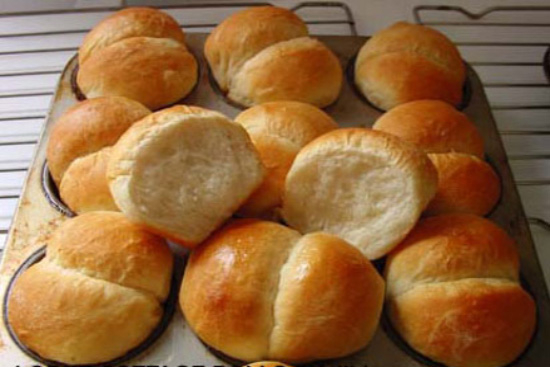
Serves: 18
Preparation time: 3 hours
Cooking time:30 minutes
1 tablespoon dry yeast
1/2 cup warm water
1 teaspoon sugar
3 cups warm water
1/4 cup sugar
1/2 cup melted shortening
1 teaspoon salt
1 tablespoon vinegar
9 cups flour Dissolve yeast in water and sugar. Let stand 10 minutes. Stir briskly and add to warm water, sugar, shortening, salt and vinegar. Beat in 6 cups flour, then knead in remaining flour for 10 minutes. Let rise in a greased bowl until doubled in bulk.
Punch dough down. Let rise 1 hour.
Preheat oven to 350 degrees.
Shape into buns, (3 small balls in muffin tins). Let rise 1 hour. Bake for 25 to 30 minutes.
Amaretto fruit bread 
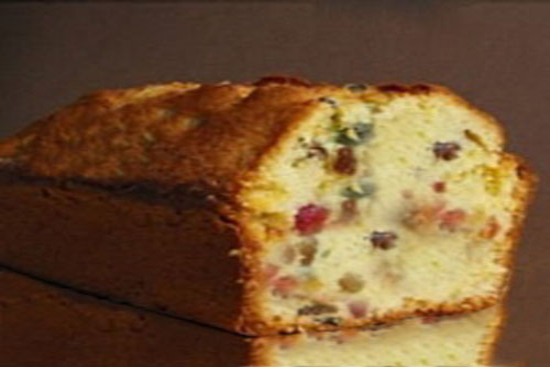
Serves: 16
Preparation time: 20 minutes
Cooking time:1 hour
1 3/4 cups flour
2/3 cup sugar
1 tablespoon baking powder
1/2 teaspoon salt
1/2 cup coarsely chopped candied cherries
1/2 cup coarsely chopped glazed pineapple
1/2 cup chopped mixed peel
1/2 cup toasted slivered almonds
1 egg
1 cup milk
1/4 cup canola oil
3 tablespoons amaretto liqueur
1 teaspoon almond flavoring Preheat oven to 350 degrees.
Grease a 9 by 5-inch loaf pan. Measure flour, sugar, baking powder and salt into a bowl. Stir until blended.
Make a well in center. Chop and measure out cherries, pineapple, peel and almonds.
Beat egg with milk, oil, amaretto and flavoring until blended. Pour into center of flour mixture.
Immediately add cherries, pineapple, mixed peel and nuts. Stir just until dry ingredients are lumpy.
Spoon batter into pan. Smooth top.
Bake until knife inserted into loaf comes out quite clean, from 1 hour to 1 hour and 15 minutes.
Store, covered, at room temperature for up to 3 days, or freeze.
Amritsari kulcha 
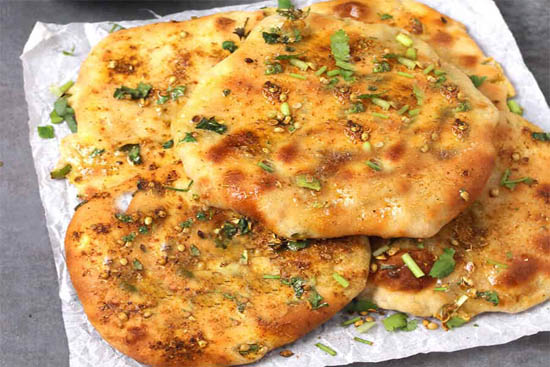
Serves: 6
Preparation time:10 minutes
Cooking time:20 minutes
The dough should be sticky and wet.
Your stuffing should be dry.
For Dough (12 Kulcha)
4 cups - Unbleached All Purpose flour / Maida
2 tablespoon - Oil
Salt to taste
2 teaspoon - Active dry yeast
2 tablespoon - Sugar
2 cups Warm Whole milk you may need 1 and ¾ cup only, depending upon the quality of your all purpose flour
For Stuffing (will make 12 balls)
2 lbs (1 kg) - Boiled Potatoes
3 - tablespoon Chopped coriander
1 tablespoon - Green chili paste we prefer little bit spicy, you may add according to your taste
Salt to taste
1 tablespoon - Chaat masala
1 teaspoon - Garam masala
Other Ingredient
Butter
All purpose flour / maida for rolling the Kulcha
Some Crushed coriander seeds
Some crushed anardaana Optional
Red chili powder
Chopped cilantro For Dough
Place warm milk in a bowl. Add oil, yeast, and sugar into the bowl. Mix well, cover it and keep it in a warm place for 10 minutes until foamy.
In a large mixing bowl, combine flour and salt. Mix them well. Add foamy milk mixture and knead a soft dough. Knead the dough for 5 to 7 minutes.
You can use the Kitchen-aid dough maker or you can knead the dough by hand.
Grease a bowl and add the dough. Brush some oil over surface of dough. Cover it with towel and let it ferment for an hour. After an hour the dough has doubled in size.
For Stuffing
Take all the ingredients in a bowl. Mix them well and divide into 12 equal size balls. Keep it aside.
Preheat Your oven @ 500 degrees F. If you are using a pizza stone, place it in the oven while preheating. If you don't have Pizza Stone, you can use cookie pan sheet, pizza pan or pizza wire tray.
Dust the working surface with a little all purpose flour. Take out the dough onto the working surface Knead the dough once with help of little bit flour. Divide them into equal size balls.
Take one ball and gently press it out a bit. Place prepared stuffing ball in the middle and close it into a ball. Do the same process with the rest of the balls.
Take one ball and spread the dough using your finger or rolling pin into a thick paratha. Sprinkle some coriander seeds, crushed anardana, chili powder, and cilantro.
Place it on a pizza stone or greased baking sheet. Bake it in a preheated oven at 500 degrees F (250 degrees C) for about 8 minutes or until top is golden brown in color.
Remove from the oven and apply butter on top.
Stove Top Version:
Place the rolled kulcha on a regular tawa, apply some ghee both the sides and cook them from both the sides over medium to high heat.
Amritsari Kulcha is ready. Apply butter or ghee and Serve them hot with Chole, sweet chutney, Dal Makhani or curd. Enjoy!!!
Apple and oat scones with cinnamon 
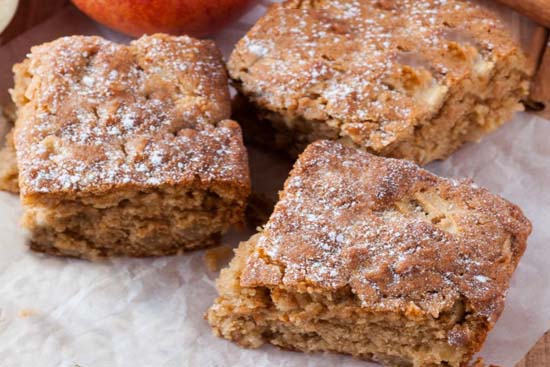
Serves: 6
Preparation time:15 minutes
Cooking time:25 minutes
1 2/3 cups all-purpose flour, plus more for rolling
1 1/3 cups old-fashioned rolled oats, plus more for topping
1/4 cup plus 2 tablespoons light-brown sugar
1/2 teaspoon ground cinnamon
1/2 teaspoon freshly grated nutmeg
2 teaspoons baking powder
3/4 teaspoon baking soda
1/2 teaspoon salt
1 1/2 sticks cold unsalted butter, cut into pieces
1 1/2 cups diced Granny Smith apple (2 apples cut into generous 1/4-inch cubes)
2/3 cup cold buttermilk, plus more for brushing
Raw turbinado sugar, for sprinkling Preheat oven to 400 degrees. Whisk together flour, oats, brown sugar, cinnamon, nutmeg, baking powder, baking soda, and salt. Cut in butter with a pastry blender or rub in with your fingers. (The largest pieces should be the size of small peas.) With your fingertips, flatten butter pieces into small disks. Add apples and buttermilk, stirring until dough just comes together.
Turn out dough onto a lightly floured work surface. Pat dough into a 6-by-8-inch rectangle, and cut into twelve 2-by-2-inch squares with a floured knife. Place about 2 inches apart on parchment-lined baking sheets. Brush tops with buttermilk, and sprinkle with raw turbinado sugar and oats. Bake until golden brown, 20 to 22 minutes, rotating sheets halfway through. Let cool on sheets for 15 minutes. Serve warm or at room temperature.
Best homemade dinner rolls 
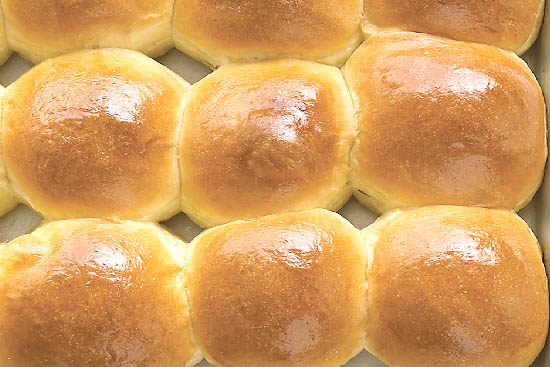
Serves: 12
Preparation time:2 hours
Cooking time:15 minutes
2 cups warm milk
2 tablespoons instant dry yeast
¼ cup white granulated sugar
2 teaspoons salt
6 tablespoons salted butter, softened
2 large eggs
6 cups all-purpose flour
1 tablespoon melted butter In the bowl of a stand mixer, combine warm milk, yeast, sugar, salt, butter, and eggs.
Add in 5½ cups of flour. Using a dough hook, turn the mixer on to a low speed. Once the flour starts to incorporate into the dough, increase the speed to a medium range. Slowly add the remaining ½ cup of flour until the dough pulls away from the sides of the bowl. The dough mixture should be slightly sticky and soft. Add more or less flour until the dough reaches the desired consistency. The amount of flour you add in bread making is always an approximation and you should go by feel.
Transfer the dough to a lightly greased mixing bowl. Cover with a towel and let rise 90 minutes.
Lightly grease a baking sheet. Punch down the dough and form into 24 rolls. Place on the greased baking sheet in six rows of four.
Cover and let rise 1 hour.
Preheat oven to 375 degrees. Bake the rolls for 12 to 14 minutes, until lightly browned.
Remove rolls from oven and brush with melted butter.
Serve the rolls warm, or to cool, let rest on the pan for 15 minutes before transferring to a wire cooling rack. Once cooled completely, store in a plastic bag.
Blueberry corn bread 

Serves: 6
Preparation time: 15 minutes
Cooking time:50 minutes
1 cup flour
1 tablespoons baking powder
1/2 teaspoon salt
1 cup yellow cornmeal
1/4 cup sugar
1 cup milk
1 large egg
1/2 cup unsalted butter, softened
1 cup blueberries Preheat oven to 425 degrees.
Butter one 9-inch by 5-inch by 3-inch loaf pans. In a medium bowl, combine flour, baking powder, salt, and sugar. Add cornmeal and blend well.
In a separate bowl, combine and beat milk, egg, and butter.
Pour the wet ingredients over dry mixture. Stir to blend. Fold in the blueberries.
Pour batter into pans.
Bake for about 50 minutes. Cool corn bread on rack for 10 minutes. Turn out onto rack to cool completely. Refrigerate wrapped for 2 days, or freeze for 2 weeks.
Blueberry scones 
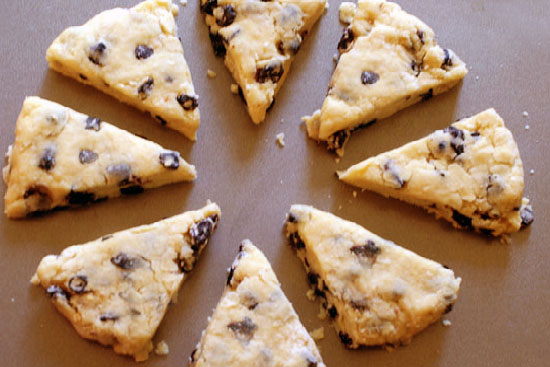
Serves: 8
Preparation time: 25 minutes
Cooking time:25 minutes
2 cups flour
1/3 cup sugar
2 tablespoons baking powder
1/4 teaspoon salt
1 cup fresh blueberries
2/3 cup cold butter, grated
2 eggs
½ cup plain Greek yogurt
½ cup milk
2 teaspoons finely grated lemon rind
1/4 cup lemon juice
Glaze:
1 tablespoon lemon juice
1 tablespoon sugar Preheat oven to 350 degrees.
Whisk together flour, sugar, baking powder and salt. Add the butter and combine mixture until crumbly. Add fresh blueberries.
Whisk together eggs, buttermilk or yogurt,milk, lemon rind and juice; drizzle over dry ingredients, tossing with a fork until mixture clumps together. Turn out onto floured surface. With floured hands, form into ball, kneading about 8 times.
Place on parchment paper-lined lightly floured baking sheet. Pat into 3/4-inch thick circle; cut into 8 wedges. Do not separate.
Glaze: Brush with lemon juice; sprinkle with sugar.
Bake for about 25 minutes or until golden. Serve warm with Wild Blueberry Preserves and Devon Cream.
Variation. Blueberry Scones:
Gently toss 1 cup fresh blueberries with dry ingredients just before adding egg mixture. Increase lemon rind to 1 tablespoon.
Adapted from Canadian Living Magazine
Brioches 
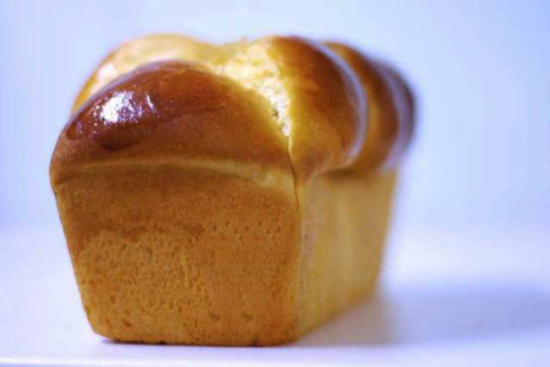
Serves: 12
Preparation time:1 hour
Cooking time:20 minutes
1/4 cup warm water (110°F to 115°F)
1/4 cup warm whole milk (110°F to 115°F)
3 teaspoons active dry yeast (measured from two 1/4-ounce envelopes)
2 3/4 cups all purpose flour
1 1/2 teaspoons salt
3 large eggs, room temperature
3 tablespoons sugar
6 oz unsalted butter, room temperature
1 large egg beaten to blend with 1 teaspoon water (for glaze) Combine 1/4 cup warm water and warm milk in bowl of heavy-duty mixer fitted with paddle attachment. Sprinkle yeast over and stir to moisten evenly. Let stand until yeast dissolves, stirring occasionally, about 8 minutes.
Add flour and salt to yeast mixture. Blend at medium-low speed until shaggy lumps form, scraping down sides of bowl occasionally, 1 to 2 minutes. Add eggs, 1 at a time, beating until blended after each addition. Beat in sugar. Increase mixer speed to medium; beat until dough is smooth, about 3 minutes.
Reduce speed to low. Add butter, 1 tablespoon at a time, beating until blended after each addition, about 4 minutes (dough will be soft and silky). Increase speed to medium-high and beat until dough pulls away from sides of bowl and climbs paddle, 8 to 9 minutes.
Lightly butter large bowl. Scrape dough into bowl. Cover bowl with plastic wrap. Let dough rise in warm draft-free area until almost doubled in volume, about 1 hour 15 minutes to 1 hour 30 minutes.
Gently deflate dough by lifting around edges, then letting dough fall back into bowl, turning bowl and repeating as needed. Cover bowl tightly with plastic wrap and chill, deflating dough in same way every 30 minutes until dough stops rising, about 2 hours. Chill overnight. (At this point, use the dough to make 12 brioches, or 6 brioches and 1 tart, or 2 tarts.)
Butter 12 standard (1/3-cup) muffin cups. Divide dough into 12 equal pieces; cut each piece into thirds. Roll each small piece between palms into ball. Place 3 balls in each prepared cup (dough will fill cup).
Place muffin pan in warm draft-free area; lay sheet of waxed paper over. Let dough rise until light and almost doubled (dough will rise 1/2 inch to 1 inch above top rim of muffin cups), 50 to 60 minutes.
Position rack in center of oven and preheat to 400°F. Place muffin pan on rimmed baking sheet. Gently brush egg glaze over risen dough, being careful that glaze does not drip between dough and pan.
Bake brioches until golden brown about 20 minutes. Transfer pan to rack. Cool 10 minutes. Remove brioches from pan. Serve warm or at room temperature.
Caramelized onion biscuits 
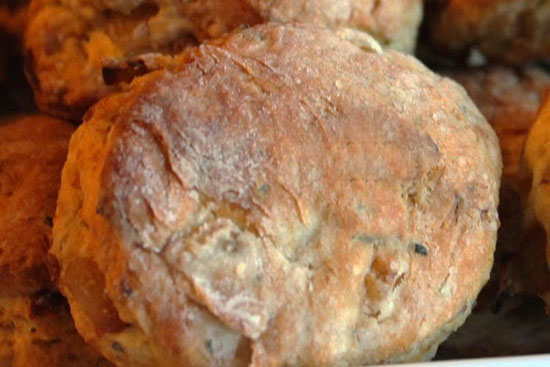
Serves: 6
Preparation time: 40 minutes
Cooking time:20 minutes
4 tablespoons butter
1 medium diced onion
2 cups flour
1 tablespoon baking powder
1/2 teaspoon salt
1/8 teaspoon pepper
6 tablespoons vegetable shortening or butter
1/2 cup milk Preheat oven to 425 degrees Fry diced onion in butter until caramelized, about 15 to 20 minutes.
Combine cooled onions, flour, baking powder, salt and pepper. Rub in vegetable shortening or butter. Mix in 1/2 cup milk. Gently knead dough. Pat out to a 1-inch thickness.
Cut into round or square biscuits. Place in a greased 9-inch pan so that they touch. Brush melted butter over. Bake until well browned, about 20 minutes.
Serve with BLACK BEAN SOUP
Challah bread 
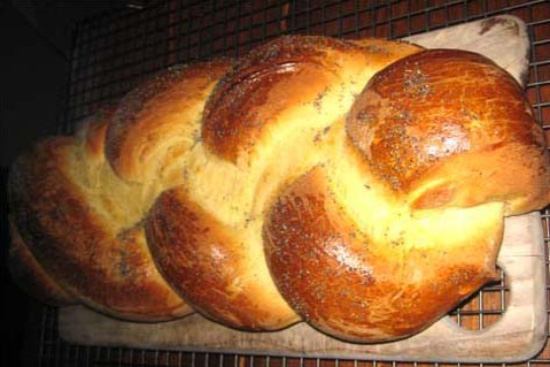
Serves: 16
Preparation time: 1 hour
Cooking time:40 minutes
1/2 cup plus 2/3 cup warm water
2 tablespoons dry yeast
1 tablespoons plus 3/4 cup sugar
5 large eggs
3/4 cup vegetable oil
2 teaspoon salt
6 cups (about) all-purpose flour
1 large egg yolk
1 tablespoon water Combine 1/2 cup warm water, yeast and 1 tablespoon sugar in large glass measuring cup and stir until yeast dissolves. Let yeast mixture stand at room temperature until foamy, about 10 minutes.
In large bowl of heavy-duty mixer fitted with whisk attachment, beat 5 eggs until blended. Add oil, salt and 3/4 cup sugar and beat until pale yellow and slightly thickened, about 4 minutes. Beat in 2/3 cup warm water. Add yeast mixture and beat until blended. Remove whisk and fit mixer with dough hook. Add enough flour 1 cup at a time to form smooth dough, beating well after each addition. Beat on medium speed until smooth and elastic, about 5 minutes, adding flour by tablespoonfuls if sticky. Turn out onto floured surface and knead 2 minutes.
Lightly oil large bowl. Add dough, turning to coat with oil. Cover with plastic wrap, then with clean kitchen towel. Let dough rise in warm draft-free area until doubled in volume, about 1 hour.
Punch down dough. Cover with plastic and clean kitchen towel and let rise 30 minutes.
Grease 2 large baking sheets. Turn out dough onto lightly floured surface. Divide dough into 2 equal portions. Divide each portion into 3 equal pieces. Roll each piece into 20-inch-long rope. Braid 3 ropes together; pinch ends together to seal. Repeat with remaining dough pieces, forming 2 braids. Place each braid on baking sheet. Cover with towel . Let rise in warm area until almost doubled, about 30 minutes.
Preheat oven to 400°F. Whisk yolk with 1 tablespoon water to blend. Brush dough with egg mixture. Bake 10 minutes. Reduce oven temperature to 350°F. Bake until bread is golden brown and sounds hollow when tapped on bottom, about 35 minutes. Transfer loaves to rack and cool.
Ciabatta bread 
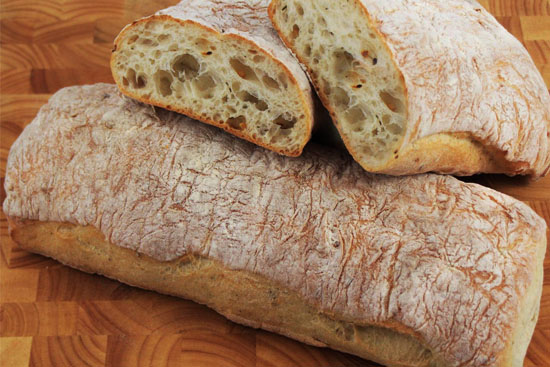
Serves: 8
Preparation time:1 hour
Cooking time:25 minutes
For the sponge:
1 cup (130 g) all-purpose flour
⅛ teaspoon instant yeast
½ cup (120 ml) water, at room temperature
For the Dough:
2 cups (260 g) all-purpose flour
1½ teaspoons salt
½ teaspoon instant yeast
¾ cup (180 ml) water, at room temperature
¼ cup (60 ml) whole or 2% milk, at room temperature Make the Sponge: Combine the 1 cup flour, ⅛ teaspoon yeast, and ½ cup water in a medium bowl and stir with a wooden spoon until a uniform mass forms. Cover the bowl tightly with plastic wrap and let stand at room temperature for at least 8 hours or up to 24 hours.
Make the Dough: Place the sponge and the dough ingredients (flour, salt, yeast, water and milk) in the bowl of a stand mixer fitted with the paddle attachment. Mix on low speed until combined and a shaggy dough forms, about 1 minute, scraping down the bowl and paddle as needed. Increase the speed to medium-low and continue mixing until the dough becomes a uniform mass that collects on the paddle and pulls away from the sides of the bowl, 4 to 6 minutes.
Change to the dough hook and knead the bread on medium speed until smooth and shiny (the dough will be very sticky), about 10 minutes.
Transfer the dough to a large bowl, cover tightly with plastic wrap, and let rise at room temperature until doubled in size, about 1 hour.
Spray a rubber spatula or bowl scraper with non-stick cooking spray. Fold the dough over itself by gently lifting and folding the edge of the dough toward the middle. Turn the bowl 90 degrees, and fold again. Turn the bowl and fold the dough 6 more times (for a total of 8 times).
Cover with plastic wrap and let rise for 30 minutes.
Repeat the folding as in step #7, replace the plastic wrap, and let rise until doubled in size, about 30 minutes.
One hour before baking, adjust an oven rack to the lower-middle position, place a baking stone on the rack and preheat the oven to 450 degrees F.
Cut two 12×6-inch pieces of parchment paper and dust liberally with flour. Transfer the dough to a floured work surface, being careful not to deflate it completely. Liberally flour the top of the dough and divide it in half with a bench scraper. Turn 1 piece of dough cut-side-up and dust with flour. With well-floured hands, press the dough into a rough 12×6-inch rectangle. Fold the shorter sides of the dough toward center, overlapping them like you would fold a letter in thirds, to form a 7×4-inch rectangle. Repeat with the second piece of dough.
Gently transfer each loaf, seam-side-down, to the parchment sheets, dust with flour, and cover with plastic wrap. Let the loaves sit at room temperature for 30 minutes (the surface of the loaves will develop small bubbles).
Slide the parchment pieces with the loaves onto a pizza peel. Using floured fingertips, evenly poke the entire surface of each loaf to form a 10×6-inch rectangle; spray the loaves lightly with water. Slides the loaves and parchment onto the baking stone. Bake, spraying the loaves with water twice more during the first 5 minutes of baking time, until the crust is deep golden brown and the loaves register 210 degrees F, 22 to 27 minutes.
Transfer the loaves to a wire rack, discard the parchment, and let cool to room temperature for at least 1 hour before slicing and serving. The bread can be wrapped in a double layer of plastic wrap and stored at room temperature for up to 3 days. Wrapped with an additional layer of foil, the bread can be frozen for up to 1 month. To recrisp the crust, thaw the bread at room temperature (if frozen), and place unwrapped bread in 450-degree oven for 6 to 8 minutes
Cinnamon apple stuffed challah 

Serves: 12
Preparation time: 20 minutes
Cooking time:35 minutes
1 envelope instant yeast
2½ cups bread flour
½ cup warm water (100 degrees)
2 eggs for the dough and 1 egg for an egg wash
¼ cup vegetable oil
1 teaspoon vanilla extract
2 teaspoons cinnamon, divided
¼ cup plus 1 teaspoon sugar, divided
1 teaspoon salt
2 apples, washed, peeled, and diced into ½ inch pieces (I used Golden Delicious) Whisk yeast and ½ cup of flour with warm water (100 degrees) into a slurry. Let it sit for 10 minutes until puffy.
Mix in two eggs, oil, vanilla, 1 teaspoon cinnamon, ¼ cup sugar, and salt into the yeast until all mixed.
Then add the rest of the flour, and mix with your hands into a shaggy ball.
Knead dough for about 10 minutes until smooth; add more water if it is tough or flour if it is sticky.
Put the dough in a clean and warm bowl and cover with plastic wrap. Let it ferment (rise) in a warm place for one hour until puffy.
Peel and dice your apples into ½ inch pieces and mix with 1 teaspoon cinnamon and 1 teaspoon sugar.
Once dough is ready, divide into three sections and roll each one out into a flat piece on parchment paper. Sprinkle some apples at one end and roll up the long way making sure to avoid air bubbles.
Repeat with other dough balls.
Braid up the strands starting in the middle, and put your challah on a sheet pan lined with parchment paper.
Cover with plastic wrap and ferment (rise) another hour and a half until it has tripled in size.
Preheat oven to 350°F.
Make an egg wash with the last egg, use pastry brush to brush it on the loaf, and bake for 35 minutes until golden brown.
Serve with honey!
Cinnamon rolls 
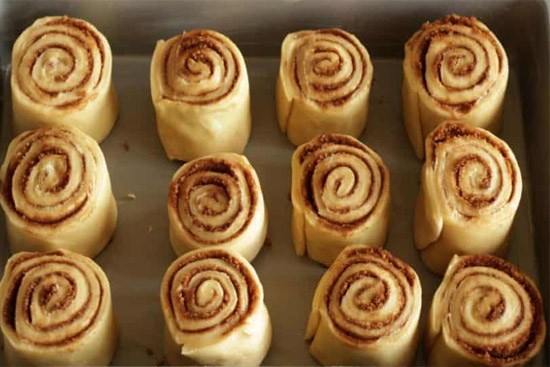
Serves: 12
Preparation time: 15 minutes
Cooking time:25 minutes
2 and 3/4 cups (345g) all-purpose flour (spooned & leveled), plus more as needed for rolling
1/4 cup (50g) granulated sugar
2 teaspoons baking powder
1/4 teaspoon baking soda
1/2 teaspoon salt
1 large egg
3/4 cup (180ml) buttermilk, cold*
5 Tablespoons (71g) unsalted butter, soft
Filling
3 Tablespoons (43g) unsalted butter, extra softened
1/3 cup (67g) packed light or dark brown sugar
1 Tablespoon ground cinnamon
Cream Cheese Icing:
4 ounces (113g) full-fat brick cream cheese, softened to room temperature
2 Tablespoons (28g) butter, softened to room temperature
2/3 cup (80g) confectioners’ sugar
1 teaspoon pure vanilla extract Preheat the oven to 375°F (190°C) and grease a round 9-inch pie dish or 9-inch cake pan.
Make the dough:
Whisk the flour, granulated sugar, baking powder, baking soda, and salt together. Add the egg, buttermilk, and melted butter. Mix with a wooden spoon or rubber spatula until a dough forms. Dough will be very soft and slightly sticky. If it’s too sticky and wouldn’t roll, refrigerate the dough until it is workable.
Place dough on a floured work surface and, using a lightly floured rolling pin, roll dough into a 10×14-inch (25x35cm) rectangle.
For the rolls: Spread softened butter (the softer it is, the easier it is to spread!) all over the dough. Mix the brown sugar and cinnamon together. Sprinkle all over the top. Roll it up tightly into a 14-inch log.
Using a very sharp knife, cut into 12 rolls; each roll is slightly wider than 1 inch. Arrange rolls in the prepared pan.
Bake the rolls:
Bake for 22–26 minutes, until lightly browned around the edges. If you notice the tops are getting too brown too quickly, loosely tent the pan with aluminum foil and continue baking.
Remove pan from the oven and place pan on a wire rack as you make the icing.
Make the icing: In a medium bowl using a handheld or stand mixer fitted with a paddle or whisk attachment, beat the cream cheese on high speed until smooth and creamy. Add the butter and beat until smooth and combined, then beat in the confectioners’ sugar and vanilla until combined. Using a knife or icing spatula, spread the icing over the warm rolls and serve immediately.
Corn bread 
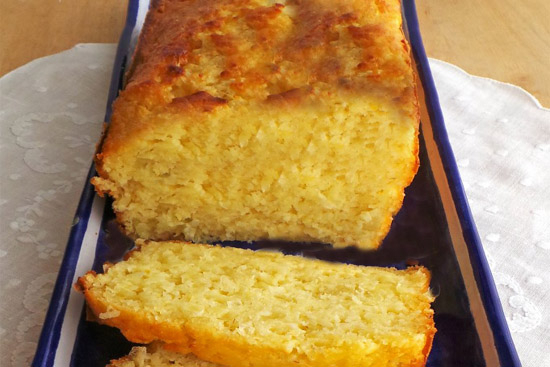
Serves: 8
Preparation time: 15 minutes
Cooking time:50 minutes
2 cups flour
2 tablespoons baking powder
1 teaspoon salt
2 cups yellow cornmeal
1/2 cup sugar
2 cups milk
2 large eggs
1 cup unsalted butter, softened Preheat oven to 425 degrees F.
Butter two 9-inch by 5-inch by 3-inch inch loaf pans. In a medium bowl, combine flour, baking powder, salt, and sugar. Add cornmeal and blend well. In a separate bowl, combine and beat milk, egg, and butter. Pour the wet ingredients over dry mixture. Stir to blend. Pour batter into pans. Bake for about 50 minutes. Cool corn bread on rack for 10 minutes. Turn out onto rack to cool completely. Refrigerate wrapped for 2 days, or freeze for 2 weeks.
Corn bread with sun dried tomatoes 
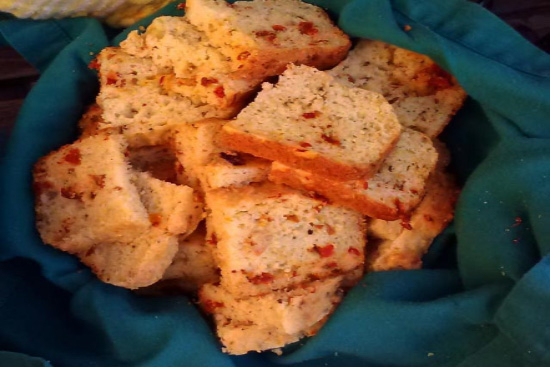
Serves: 12
Preparation time: 20 minutes
Cooking time:30 minutes
2 1/2 cups yellow cornmeal
1 1/2 cups flour
1/2 cup sugar
1 tablespoon dried rubbed sage
1 tablespoon ground black pepper
1 1/2 teaspoons salt
1 1/2 teaspoons baking powder
3/4 teaspoon baking soda
2 1/4 cups buttermilk
1 cup chopped drained oil packed sun dried tomatoes, 1/4 cup oil reserved
1/2 cup butter, melted
4 large eggs Preheat oven to 400 degrees.
Butter two 9 1/2-inch diameter deep dish pie dishes. Combine cornmeal, flour, sugar, sage, pepper, salt, baking powder and baking soda in large bowl and whisk to blend.
Combine buttermilk, sun dried tomatoes, reserved oil, butter, eggs and whisk to blend. Stir buttermilk mixture into dry ingredients.
Divide corn bread batter between prepared dishes. Bake corn breads until tops begin to brown and tester inserted in center comes out clean, about 30 minutes. Cool slightly.
Cut corn breads into wedges; serve warm.
Note: Corn breads can be prepared 6 hours ahead. Cool completely.
Cover with aluminum foil. Reheat covered in 350 degree oven about 10 minutes.
Cramique brioche 
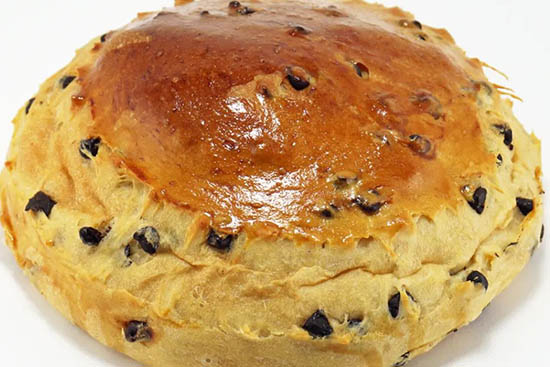
Serves: 6
Preparation time:2 hours
Cooking time:40 minutes
530g strong white flour
85g sugar
12g salt
1 x 11g sachet of dry yeast
50ml milk
5 eggs
210g softened butter
140g raisins In a bowl, mix the flour, salt and sugar.
Mix the yeast into the warm milk, pour into the bowl then add the eggs and the softened butter.
Knead until the dough comes away from the sides of the bowl. Add the raisins. Mix again until you have an even consistency.
Bring the dough into a ball, put it back in the bowl and cover with a cloth. Leave to rest in a warm place for one hour until the dough has doubled in volume.
Divide the ball into equal parts and shape them into small balls, then put them in a cake tin or on a baking sheet, cover and leave to rest for two hours.
Bake for about 40 minutes in an oven preheated to 180°C (350F) and keep an eye on them towards the end of the cooking time.
Croissants 
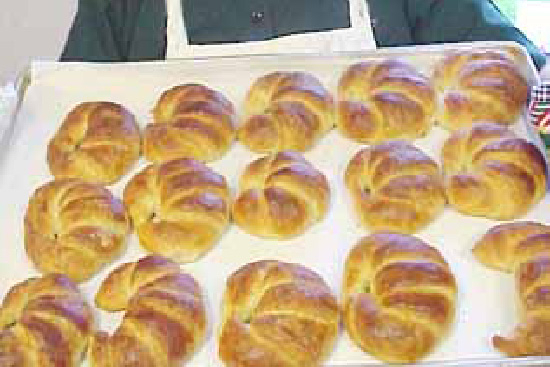
Serves: 20
Preparation time: 4 hours
Cooking time:20 minutes
For the sponge:
1/4 teaspoon active dry yeast
3/4 cup warm water
2 cups (9 ounces by weight) all-purpose flour
For the croissant dough:
1/4 cup warm water
3/4 cup milk
6 tablespoons sugar
2 packages (4 1/2 teaspoons) active dry yeast
2 1/2 cups (11 1/4 ounces by weight) all-purpose flour
1 tablespoon salt
1 3/4 ounces unsalted soft butter
10 ounces unsalted butter, chilled
1 egg for egg wash
For the sponge:
In an electric mixing bowl, stir the warm water and yeast together. Allow to foam for 5 minutes.
Mix in the flour at low speed. The dough will be sticky. Cover and let rest for 12 hours at room temperature.
For the croissant dough: In a mixing bowl, combine water, milk, and 1 teaspoon of sugar.
Stir in the yeast to dissolve and allow to foam for about 3 minutes. Add the remaining sugar, flour, salt, soft butter and the sponge. Knead with the dough hook for about 10 to 12 minutes. (If working by hand, knead for 15 minutes.)
Transfer dough to a lightly oiled bowl. Cover with plastic wrap and allow to double in bulk in a draft-free area at room temperature, about 1 hour.
On a lightly floured surface, roll the dough into a rectangle 12 by 14- inches. Place the dough rectangle on a baking sheet. Cover with plastic and freeze for about 30 minutes to get the consistency of chilled butter. Roll the 10 ounces of chilled butter between plastic sheet to form a rectangle 12 by 7 inches.
Square up rectangle with a spatula or dough scraper. Position the butter rectangle on one side of the dough. Fold the rest of dough over butter and seal edges to seal in butter. Roll out the dough into a 10 by 20-inch rectangle. Fold one-third of the dough towards the center. Fold the other third over the two layers. Wrap the dough in plastic and refrigerate 30 minutes.
Repeat the rolling and folding process twice more and chill. Finally, on a floured surface, roll the dough into a 19 by 25-inch rectangle. Cut the dough into 20 even triangles.
Use a template for accurate measurements. To roll the crescents, start at the base and roll towards the tip. Finish the roll so that the tip is underneath the croissant.
Curve the end of each croissant and brush with egg wash. (May be frozen at this time). Arrange croissant on a baking sheet lined with parchment.
Let them rise uncovered at room temperature or until doubled in bulk. Bake the croissants at 375 degrees for 18 to 20 minutes.
Crumpets 
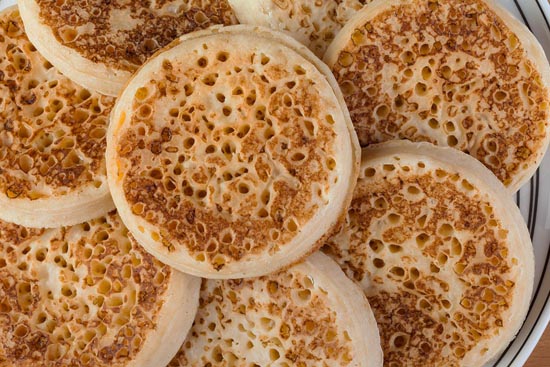
Serves: 12
Preparation time: 2 hours 45 minutes
Cooking time:40 minutes
1 1/4 cups milk
3 1/2 cups all-purpose flour
1 1/4 cups water, lukewarm
1 tablespoon sugar
2 1/2 teaspoons instant yeast
1/2 teaspoon baking powder
1/2 teaspoon fine sea salt
Vegetable oil for cooking
Whisk together the milk, flour, yeast and sugar. Once combined add half the water and beat into the batter, continue to add more water until the batter is thick and smooth. Stop adding water once it reaches the consistency of thick cream. Cover with cling film and leave in a warm draft free place until foaming - about 1, up to 2 hours.
Whisk the salt and baking powder into the batter then heat a heavy based frying pan on the stove to hot but not smoking.
Dampen a paper towel with a little oil and grease the base of the pan and a crumpet (or pastry) rings measuring 3 ½"
Place one ring in the heated pan, add enough batter to fill just below the top of the ring.
Cook for five minutes when there should be many tiny holes on the surface and the crumpet is setting. Flip the crumpet over and cook for another two – three minutes.
Repeat with the remaining batter until used up. Rest the crumpets on a wire rack until cool and reheat in a toaster or under the grill before serving.
NOTE: If the batter seeps from under the ring it is too thin, whisk in more flour. If the crumpet is heavy and without holes, the batter is too thick, add more water.
Cuchaule - saffron bread recipe 
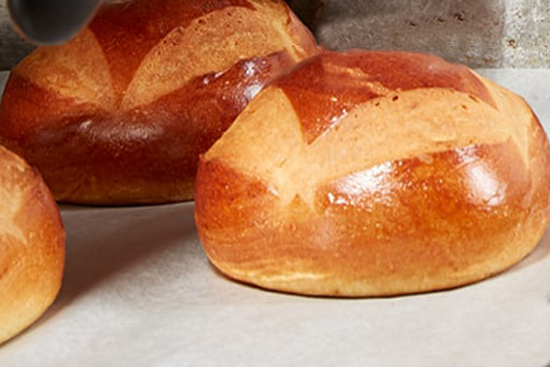
Serves: 8
Preparation time:1 hour
Cooking time:35 minutes
Origin: Fribourg, 16th century
Origin of the name: from the Fribourg dialect "kûchola"
Although traditionally served with butter and Benichon mustard, cuchaules can also be used as burger buns.
550 g bread flour (2.1/3 cups)
80 g (2.5 oz)sugar
1 tsp salt
1 to 2 pinch saffron powder
½ cube yeast or 2 1/4 teaspoons usually for most active dry yeast single packs in the North America
60 g (2 oz) butter, melted and warm
3 deciliter of milk (3 deciliters=1 1/4 cups)
2 eggs, beaten separately
Dissolve the yeast in 1/2 cup warm milk and a teaspoon sugar. After 5-10 minutes, the mixture should be foamy.
Mix flour, sugar, salt and saffron in an extra-large mixing bowl.
Add yeast to flour mixture and stir.
Add milk and warm melted butter and stir.
Add saffron and one egg and mix well.
Knead until it forms a soft, smooth dough and it no longer sticks to sides of bowl.
Let it rise until it doubles in volume, about 2 hours.
Put dough onto floured working surface, and shape it into two round breads.
Cover baking sheet with wax paper and place loaves on baking sheet.
Use a knife to form a criss-cross pattern on the top of each loaf.
Let dough rise a second time at room temperature for 30 to 45 minutes.
Preheat oven to 180° C. (360° F)
Use a pastry brush to coat each loaf with the remaining beaten egg and bake for 30 to 35 minutes or until golden brown.
Cool before cutting.
Double cranberry soda bread 
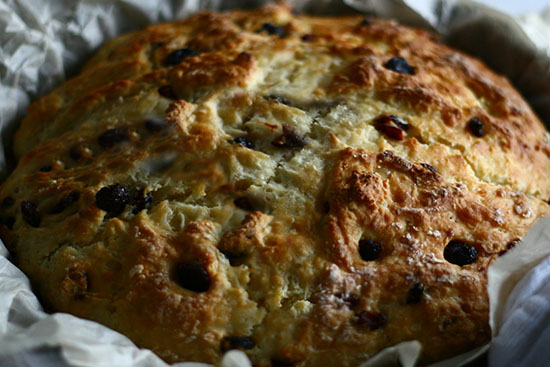
Serves: 8
Preparation time: 30 minutes
Cooking time:45 minutes
1/4 cup fresh orange juice
1 teaspoon orange zest
3/4 cup soy milk or rice milk
3 tablespoons canola oil
1 1/2 cups whole wheat flour
1 cup pastry flour
1 teaspoon baking soda
1/4 cup sugar
1 cup fresh cranberries, roughly chopped
1/2 cup dried cranberries
1/4 cup lightly toasted, chopped walnuts (optional) Preheat oven to 350 degrees.
Lightly oil a baking sheet or line with parchment paper. Combine juice and zest of orange with the soy or rice milk to make 1 cup. Add oil and whisk together with a fork. Set aside.
Blend flours and baking soda together, stirring to make sure there are no small lumps of soda.
Mix in sugar, fresh and dried cranberries, and walnuts, if desired. Add liquid ingredients to dry ingredients, stirring until a stiff dough is formed.
Turn dough out onto a lightly floured board and knead a few turns. Shape into a round loaf and place on the prepared baking sheet. With a sharp knife cut an X across the top about ½-inch deep (to allow for dough expansion when baking).
Bake 40 to 45 minutes, or until a toothpick comes out clean and the top is browned. Remove to cooling rack. Cool 10 to 15 minutes before slicing.
Dutch baby apple pancake 
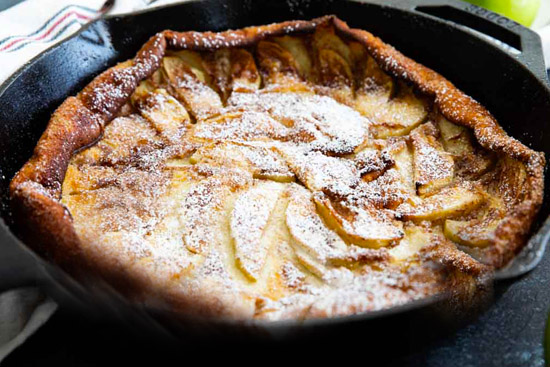
Serves: 4
Preparation time: 15 minutes
Cooking time:25 minutes
To serve, slide the pancake from the skillet onto a round serving platter, and present it apple side up.
1 1/2 tablespoons unsalted butter
1 Granny Smith apple, peeled, cored, and cut into 1/2 inch wedges
1/3 cup honey
1/4 teaspoon ground cardamom
3 large eggs
3/4 cup milk
3/4 cup all purpose flour
1/4 teaspoon salt
1 tablespoon confectioners' sugar Heat oven to 400 degrees. Heat a well seasoned 10 inch cast iron skillet over high heat. Add butter. When melted, add apple wedges. Cook until softened and lightly golden, about 2 minutes. Stir in honey and cardamom, and remove skillet from heat.
In a separate bowl, whisk together remaining ingredients, except confectioners sugar, until smooth. Pour over apple mixture. Bake until puffed and brown, about 20 minutes.
Slide pancake onto a serving platter. Serve immediately, cut into wedges, with confectioners' sugar sifted over the top.
English muffins 
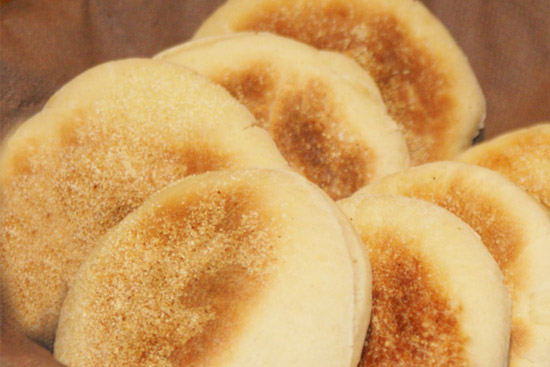
Serves: 12
Preparation time:3 hours
Cooking time:20 minutes
This recipe also makes a firmer dough than some other English muffin recipes, it makes the dough much easier to work with.
This recipe is inspired by http://www.emmachristensenmedia.com/
For the dough starter:
3/4 cup (3 1/3 ounces) all-purpose flour or bread flour
1/2 cup water
1/2 teaspoon active dry or instant yeast (or 2 tablespoons active sourdough starter)
For the English muffin dough:
1 cup milk, whole or 2%
1 teaspoon active dry or instant yeast
2 tablespoons sugar
2 tablespoons unsalted butter, melted
1 teaspoon salt
3 to 3 1/4 cups (13 1/2 to 14 1/2 ounces) all-purpose flour or bread flour
Cornmeal for dusting
Butter for the skillet
1. Make the dough starter: Mix the flour, water, and yeast for the starter in a small mixing bowl. Beat until the batter is smooth and glossy, about 100 strokes.
2. Let the starter sit 1 to 12 hours: Cover the starter and place it out of the way for at least 1 or up to 12 hours. The starter will become increasingly bubbly the longer it sits and will double in bulk. The longer you can let the starter ferment, the better the flavor and structure of your finished English muffins.
3. Whisk together the milk, yeast, and starter: In the bowl of a stand mixer or large mixing bowl, combine the milk and yeast for the dough. Scrape the starter into the bowl and use a whisk to break it up and dissolve it into the milk. It should become quite frothy.
4. Mix the dough together: Add the sugar, butter, and salt to the bowl and whisk to combine. Add 3 cups of the flour and stir with a stiff spatula until you form a shaggy, floury dough.
5. Knead the dough: With a dough hook on a stand mixer, knead the dough until it comes together in a smooth ball, 5 to 8 minutes. Alternatively, knead by hand against the counter. If the dough is very sticky like bubble gum, add extra flour as needed, but err on the side of caution. The dough is ready when it forms into a smooth ball and springs back when poked; it will feel slightly tacky to the touch, but shouldn't stick to the bowl or your hands.
6. Let the dough rise overnight in the fridge: Transfer the dough to a large bowl lightly filmed with oil. Cover and place in the fridge overnight or for up to 3 days.
→ Quicker English Muffins: You can also let the dough rise at room temperature until doubled in bulk, 1 1/2 to 2 hours, and then make the muffins immediately. These muffins will have a milder flavor.
7. Divide and shape the muffins: Turn the risen dough out onto a lightly floured work surface. Use a pastry scraper to divide the dough into 12 equal pieces. Roll each piece gently against the counter to shape into smooth, round balls.
8. Transfer the muffins to a baking sheet to rise: Scatter cornmeal generously over a baking sheet and arrange the balls on top, spaced a little apart. If you have muffin rings, place them around the balls at this point. Sprinkle the tops of the balls with more cornmeal.
9. Let the muffins rise until puffy: For dough that was refrigerated, this will take 1 1/2 to 2 hours; for room temperature dough, this will take about 1 hour. Depending on the size of your muffin rings, the muffins may not totally fill the rings — that's okay.
10. Warm a skillet: When ready to cook the muffins, warm a large skillet over medium heat. Melt a small pat of butter — enough to just coat the bottom of the pan and prevent sticking.
11. Cook the muffins 5 to 6 minutes on one side: Working in batches, transfer a few of the muffins to the skillet — allow an inch or so of space between muffins and do not crowd the pan. If using rings, transfer the muffins with their rings to the pan. Cook until the bottoms of the muffins are golden brown, 5 to 6 minutes.
12. Flip and cook 5 to 6 minutes on the other side: Flip the muffins and cook the other side until golden brown, 5 to 6 minutes. If you prefer thinner, less puffy English muffins, you can gently press the tops with the spatula to prevent them from rising too much.
13. Adjust the heat as needed: If your muffins seem to be browning too quickly on the bottoms (or not quickly enough), adjust the heat as needed. (If you find that your muffins are browning too quickly, throw them in the oven at 350°F to finish baking through.)
14. Finish cooking all of the muffins: Transfer cooked muffins to a cooling rack. Continue working in batches until all the muffins have been cooked. Add a small pat of butter to the pan between batches to prevent sticking.
15. Split and serve! Split the English muffins with a fork, spread with butter or jam (or both!), and eat. English muffins will keep for several days in an airtight container on the counter and are fantastic warmed in the toaster oven. Fresh English muffins can also be wrapped tightly in plastic wrap or aluminum foil, and kept frozen for up to 3 months.
Recipe Notes
Vegan English Muffins: Replace the milk in the main dough with water, almond milk, or soy milk. Replace the butter with olive oil.
Crumpets: Increase the milk by 3/4 cup — this will make a looser dough, closer to a batter. Instead of shaping muffins by hand, allow the batter to come to room temperature after refrigeration, then drop generous spoonfuls onto a hot skillet, using English muffin rings as molds. Allow to cook until bubbly (like pancakes), then flip and cook the other side.
Ethiopian injera pancake 
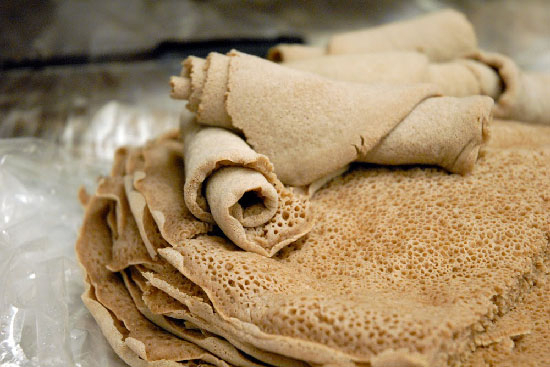
Serves: 4
Preparation time:15 minutes
Cooking time:30 minutes
The recipe can be prepared without fermentation —and the injera will not be sour.
If you want to prepare it this way, just skip the fermentation step, mix all ingredients in a bowl and cook.
Store in an airtight glass container in the fridge.
1 1/2 cups teff flour
2 cups pure water
1/2 tsp baking powder
Coconut oil for pan
1/4 tsp salt, or more to taste Place Teff flour in a large glass bowl, add water and stir well.
Cover with a cheesecloth or towel and place on the counter and let it sit for 1 day/24hrs. Do not agitate or stir the batter, just leave it be.
After 24 hours, you’ll see that your batter is fermenting.
Bring a pan to medium heat, and very lightly, coat the pan with coconut oil.
Stir in the salt, and season with more taste if you like, until you can barely detect the saltiness. Also stir in the baking powder.
Your batter will deflate when you stir it.
Now pour enough batter into the pan to fill entire surface and cover with a lid, or if you don’t have a lid, use a cookie sheet.
It’s important to keep a lot of moisture in the pan or the Injera will crack.
You don’t flip Injera.
It takes about 5-7 minutes to cook Injera. You’ll see the top bubble like pancakes and start to dry out. When the top is dry, and the edges begin to curl/dry, use a spatula to remove the Injera from the pan.
Place on a plate and repeat, layering cooked Injera with parchment paper until you use up all the batter.
Fast focaccia 
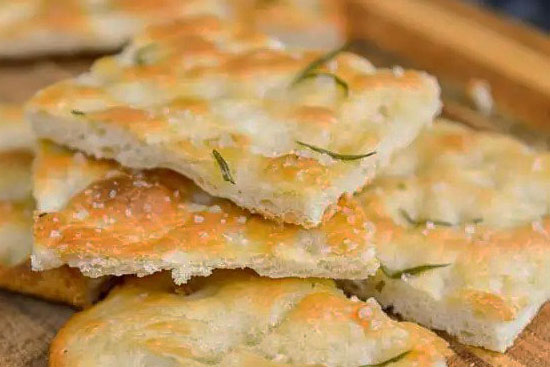
Serves: 6
Preparation time:2 hours 30 minutes
Cooking time:25 minutes
1/2 cups plus 2 tablespoons lukewarm water
1/4 cup extra-virgin olive oil
1 1/2 teaspoons (8 grams) dried instant yeast
2 1/4 teaspoons (16 grams) kosher salt
1 tablespoon (11 grams) sugar
3 3/4 cups (18 ounces; 511 grams) unbleached all-purpose flour, plus more for dusting
1 teaspoon finely chopped rosemary
Coarse or flaky salt, for sprinkling
Use a wooden spoon or sturdy spatula to stir together the water, half the oil, the yeast, kosher salt, sugar and flour in a large (five- or six-quart) bowl, forming a rough dough. Transfer to a container with a lid; partially cover and let it rest for about two hours on the counter. (Alternately, if you have a lidded container large enough for mixing, you can assemble the dough in there.) The dough can then be used right away, but it is much easier to handle once it has been thoroughly chilled. The dough can be stored in the refrigerator for up to two weeks.
Place a baking stone on the middle oven rack; preheat the oven to 425 degrees. Pour the remaining oil into a 9-inch cake pan and evenly coat the bottom of the pan.
Dust the surface of the refrigerated dough lightly with flour, then pull half of it off (it will be about a 1-pound portion; the dusting makes this task easier, as the dough is sticky). Dust the half you are using with more flour and quickly shape it into a ball by stretching the surface of the dough around to the bottom on all four sides, rotating the ball a quarter-turn as you go.
Use your hands to flatten it into a half-inch-thick round six to seven inches in diameter. Place the dough top-side-down in the cake pan, moving it around a bit to coat it with the oil. It will not fill to the edges of the pan. Turn the dough over, cover the pan with plastic wrap, and let the dough rest for 10 to 15 minutes.
Use your hands to gently push the dough to the edges of the cake pan. Sprinkle with the rosemary and coarse or flaky salt, as needed.
Cover with plastic wrap, and allow the dough to rest and rise for 20 minutes.
Place the cake pan on the heated baking stone in the oven. Bake for 20 to 25 minutes, or until the focaccia crust is medium brown and feels dry and firm on the surface. The baking time will vary, depending on the focaccia’s thickness.
Use a rounded knife to loosen the loaf from the edges of the pan, then transfer the focaccia to a cutting board. Cut into wedges and serve warm, or allow to cool completely.
Fougasse bread 
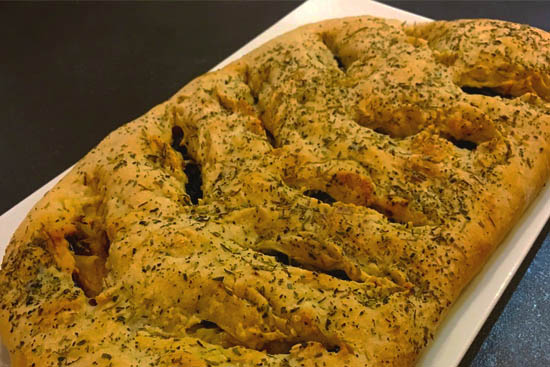
Serves: 10
Preparation time:30 minutes
Cooking time:25 minutes
For the Yeast starter::
1/2 cup warm water
1/4 teaspoon active dry yeast
1 cup all-purpose flour
For the Dough:
1/2 cup warm water
1/2 teaspoon active dry yeast
2 tablespoons olive oil
1 1/2 cups all-purpose flour, plus more for dusting
1 teaspoon finely chopped rosemary
1 teaspoon finely chopped thyme
1/2 teaspoon coarse salt
For the Garnish:
1 tablespoon olive oil
1 teaspoon coarse salt
1 teaspoon finely chopped rosemary
1 teaspoon finely chopped thyme
For the Preferment starter:
Pour the warm water into a medium bowl and whisk in the yeast. Let the mixture stand for 10 minutes.
Stir in the flour until the mixture is smooth and slightly elastic. It will be a little loose.
Cover the bowl and set aside for 3-4 hours at room temperature, or up to 12 hours in the refrigerator.
For the Bread:
Pour the warm water into the bowl of a stand mixer. Add the yeast, whisk by hand to blend, and let the mixture stand for 10 minutes.
Fit the stand mixer with the dough hook attachment. Add the preferment and the olive oil and mix on low speed for 1 minute. Add the flour, rosemary, thyme, and salt. Mix on low speed until it comes together in a cohesive mass, about 2-3 minutes. It will look wet and sticky.
Cover the bowl with plastic wrap, and let it rest for 20 minutes to allow it to fully hydrate before any further kneading.
Turn the mixer to medium-low and continue to mix until the dough is firm, elastic, and smooth, about 5-7 minutes. It will still be soft. Add more flour, one tablespoon at a time, if the dough feels too sticky to work with.
Lightly oil a large bowl, and transfer the dough to the bowl, rolling it around in the oil. Cover tightly with plastic wrap and let the dough rise until doubled in size, 1 1/2-2 hours.
Turn the dough out onto a lightly floured work surface. Gently press down on the dough to expel some of the air bubbles. Cut the dough in half, and transfer each half to two baking sheets lined with parchment paper or silicone mats. Using your hands, lightly stretch and form the dough into a large leaf shape.
Make the design, using a sharp knife to cut slits in the dough to resemble leaf veins: one slit down the center, then two or three slits at an angle on each side of the center. If using silicone mats, be careful to not cut through the material. Gently stretch out each slit to make decorative holes.
Cover the dough loosely with plastic wrap, and let the dough proof for 30-40 minutes.
While the dough is proofing, preheat the oven to 425°F.
Gently brush the surface of the proofed dough with olive oil, and sprinkle salt and chopped herbs on top. Bake for 20-25 minutes, until the bread is golden brown. Transfer to a cooling rack to cool slightly. Serve while still warm.
Greenlandic cake 
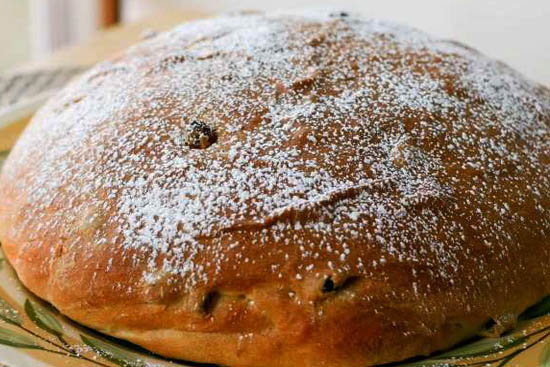
Serves: 8
Preparation time:30 minutes
Cooking time:45 minutes
Greenlandic Cake is more of a sweet bread than an actual cake.
1/2 cup sugar
1/2 cup raisins
1/2 cup butter
1 cup boiling water
2 1/4 teaspoons dry active yeast
1/4 cup lukewarm water 110 – 120 F
3 3/4 cups all purpose flour
1 tablespoon milk
1 tablespoon confectioner’s sugar
1/4 teaspoon ground cardamom Place sugar, raisins and butter in a large bowl. Add boiling water and leave until butter melts.
Meanwhile, in a small bowl, dissolve a 1/4 teaspoon sugar in the lukewarm water. Sprinkle yeast on top and leave 5-10 minutes until it becomes foamy.
Add yeast to the other ingredients and mix to combine.
Add 2 cups flour and mix until you have a shaggy dough.
Add the remaining flour, a little at a time, until you have a soft and elastic dough. Knead well for 5 minutes.
Place in a lightly greased bowl. Cover loosely with plastic wrap and a clean kitchen towel. Leave to rise for about 1 hour until doubled in size.
Preheat oven to 400 F.
Place parchment paper on a cookie sheet and spray with non stick spray.
Shape dough into a round and place on the cookie sheet. Cover with a towel and leave to rise for 30 minutes.
Brush the top with milk and bake for 30 minutes.
Reduce oven to 350 F. Bake for another 15 – 30 minutes, until it sounds hollow when tapped.
Hokkaido brioche 
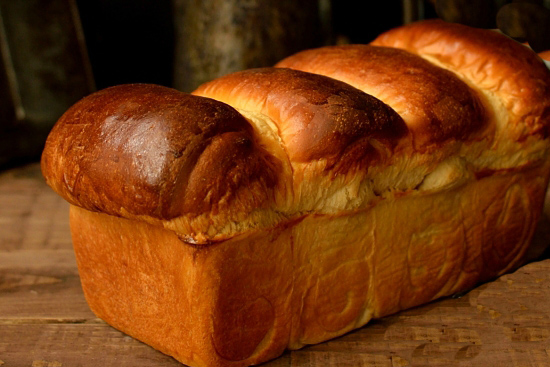
Serves: 8
Preparation time:2 hours
Cooking time:30 minutes
Tangzhong
• 20 g (3/4 oz) strong white bread flour
• 75ml (6 tbsp) water
• 1 tbsp whole milk
Dough
• 350 g (scant 3 cups) strong white bread flour
• 7 g (2 tsp) fast action yeast
• 1 tsp salt
• 60 g (scant 1/3 cup) sugar
• 1 tbsp milk powder
• 1 egg
• 120 ml (1/2 cup whole milk
• 30 g (2 tbsp) softened butter
• 1 egg beaten with a splash of milk, to glaze
To make the tangzhong:
Combine all of the ingredients in a small saucepan, and whisk until no lumps remain.
Place the saucepan over low heat, and cook the mixture, whisking constantly, until thick and the whisk leaves lines on the bottom of the pan, about 3 to 5 minutes.
Transfer the tangzhong to a small mixing bowl or measuring cup and let it cool to room temperature.
To make the dough
1. Place the flour in a large bowl (or the bowl of your stand mixer, fitted with a dough hook) and add the yeast to one side, the salt, sugar and milk powder to the other (if the salt is added on top of the yeast it can kill it), stir to combine.
2. Whisk together the cooled tangzhong, egg and milk and add it to the dry ingredients. Mix everything together until it forms a soft, shaggy dough. If you are kneading by hand, turn the dough out onto a worktop and knead for 5-10 minutes until it starts to feel smooth and a little less sticky (it will still be very sticky), add no more than a spoonful of flour while you are kneading, the dough is meant to be sticky! The best way to knead a wet dough by hand is to stretch it up away from the worktop (it will stick), then slap it back down, make sure that you pull from a different section each time and keep a dough scraper handy. If you are using a stand mixer, mix for 5 minutes or so until the dough is smooth.
3. Add the butter and mix until it is fully incorporated, continue to knead until the dough is very elastic and begins to come away from the worktop (or sides of the stand mixer bowl) cleanly. It should pass the windowpane test - stretch the dough with your hands, you should be able to stretch it to a very thin, almost transparent membrane without it tearing. This can take up to 20 minutes of kneading, especially by hand.
4. Place the dough in a lightly oiled bowl and cover with clingfilm, leave to rise for 1-2 hours until well doubled in size. Alternatively, place it in the fridge to rise overnight. If you refrigerate it, the following day let it come up to room temperature for about half an hour before continuing.
5. Line an 8.5x4.5in (or thereabouts) loaf tin with greaseproof paper. Once the dough has risen, punch it down and fold it in on itself a couple of times. Turn out onto a lightly floured surface, divide it in to four equal pieces and roll each one into a ball.
6. Roll each ball out into a long oval, fold one third of the oval over the middle (from the side, not the top), then the other third over the top to form a long, narrow packet. Roll over the seam to flatten it, then roll it up from one end to make a fat sausage. Repeat with the other balls of dough then arrange them in the loaf tin, seam side down.
7. Loosely cover with oiled clingfilm and leave to rise until at least doubled in size, this can take 1-2 hours (mine took nearly 2). If you press the dough gently with a finger the indentation should spring back slowly but remain visible. If it springs back quickly it needs to proof for a little longer. Preheat the oven while the dough is rising to 180C/350F/gas mark 4.
8. Brush the top of the dough with some of the beaten egg then bake on the lower middle shelf of the oven for 30-40 minutes until well risen and the bread sounds hollow when tapped on the bottom, the internal temperature should reach 94C/200F on a probe thermometer. Cover the bread with foil partway through baking if it starts to get too dark.
9. Transfer to a wire rack and leave to cool completely before slicing.
Homemade pizza dough 
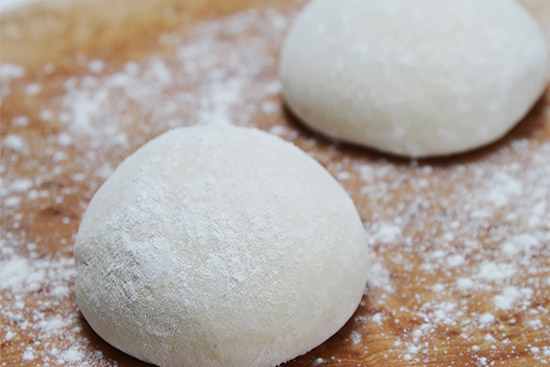
Preparation time: 15 minutes
1 tbsp. – dry active yeast
2 cups – warm water
2 tbsp. – dry milk powder
2 tbsp. – granulated sugar
2 tbsp. – olive oil
4 cups - white bread flour or Manitoba flour or Tipo '00' flour
1 tsp. – salt
Using a bread machine:
Place all dry ingredients into a bread machine maker pan if available
Add lukewarm water. Set the bread machine to dough cycle. Place the bread machine pan into the bread machine maker.
It takes about 30 minutes for the dough cycle to mix the dough. The rest of the cycle the dough will be rising for about one hour.
To make dough by hand:
Combine yeast, water, milk powder and olive oil in a large mixing bowl. Stir well and allow the yeast to develop. Add flour and salt. Knead the dough into a ball shape. Transfer the dough onto a large greased bowl. Let dough rise until doubled in volume.
Knead the dough and split in two equal halves. Each half of the dough makes one 13” pizza. You can freeze the second half of the dough is it is not used. Just coat it with olive oil, and place it into a freezing bag. You can freeze the dough for a couple of months, and then when the dough is needed, just place it overnight into refrigerator to thaw.
Irish soda bread 
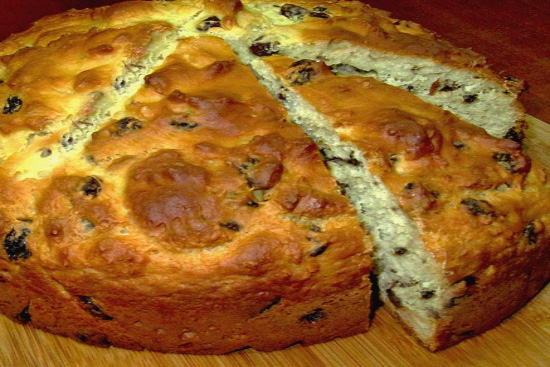
Serves: 8
Preparation time: 20 minutes
Cooking time:35 minutes
2 1/2 cups all-purpose flour
3 tablespoons sugar
2 teaspoons baking powder
1 teaspoon baking soda
1/2 teaspoon salt
1/3 cup cold butter
1 1/4 cups buttermilk*
1/2 cup currants or raisins
Heat oven to 375°F. Combine all ingredients except buttermilk and currants in large bowl; cut in butter until mixture resembles coarse crumbs. Stir in buttermilk and currants just until moistened.
Turn dough onto lightly floured surface; knead gently 10 times. Shape into ball. Place onto greased baking sheet. Pat into 6-inch circle.
Cut 1/2-inch deep “X” in top of dough with sharp knife. Bake for 30 to 35 minutes or until golden brown. Serve warm.
*Substitute 4 teaspoons vinegar or lemon juice plus enough milk to equal 1 1/4 cups. Let stand 10 minutes.
Khachapuri cheese bread 

Serves: 4
Preparation time:1 hour
Cooking time:10 minutes
For the dough
¼ cup non-dairy milk
½ cup + 2 tablespoons water
½ teaspoon sugar
1½ teaspoons active dry yeast
1¾ cup all-purpose flour
1 teaspoon salt
1 teaspoon olive oil + more for greasing and brushing
For the “cheese sauce”
6 oz baking potato, peeled and chopped bite-sized
½ small carrot, chopped bite-sized
¾ tablespoons nutritional yeast
¾ teaspoon vinegar
½ teaspoon salt
2-3 tablespoons water
1½ tablespoons olive oil
3 tablespoons onion, chopped finely
3 tablespoons poblano, chopped finely
½ garlic clove, diced finely
½ teaspoon chipotle in adobo sauce
A pinch of ground cumin
For the final assembly/garnish
2 teaspoons non-dairy milk
2 cup mozzarella (optional)
1 spring onion, sliced
Red pepper flakes (optional) Make the dough
In a microwave-proof bowl, combine non-dairy milk and water, and heat for 30-45 seconds or until the temperature reads 105°F – 115°F (the temperature range to activate the yeast).
Add sugar and active dry yeast, stir and let sit for 5-10 minutes until the yeast is activated and becomes frothy on the top.
While the yeast is activating, in a bowl, combine flour and salt. Make a well in the center.
Pour the activated yeast solution in the center and knead the dough. It will be sticky at the start, but as the gluten begins to develop, it’ll get less sticky and springier.
Once the dough is soft, smooth and springs back when pressed, add 1 teaspoon olive oil and coat bowl and dough generously.
Cover with a damp cloth and let proof in a warm spot for 1-1½ hours until doubled in size.
Make the “cheese sauce”
When the dough has been proofing for about an hour, bring a small pot of water to a rolling boil.
Add the chopped potato and carrot and cook until tender. Drain and add to a blender along with the nutritional yeast, vinegar and salt. Blend until smooth and creamy adding 2-3 tablespoons of water till you get a nice pourable consistency. Set aside.
In a small skillet, heat oil on medium heat and sauté the chopped onion, poblano and garlic with a pinch of salt until it begins to soften and brown.
Add the chipotle in adobo sauce, ground cumin. Adjust salt to taste. Remove from heat and stir into the blended potato sauce. Set aside.
Shape the dough
Preheat oven to 450°F. Line a medium baking tray with parchment paper.
Divide the proofed dough into two equal halves, kneading each until soft and smooth. Keep the other dough half-covered as you’re working with the first one.
Sprinkle a clean, dry work surface generously with flour and roll out one piece of dough into a circle about 10” in diameter.
Roll the top and bottom edges of the circle, and shape like a boat, twisting the left and right ends to seal the edges.
Repeat with the other dough. Transfer both “boats” to the prepared baking tray.
Brush the edge of each khachapuri with a little oil, and non-dairy milk.
Let them sit and rise for another 10 minutes.
Bake!
Bake in the preheated oven at 450°F in the middle-rack for 8 minutes.
Remove from the oven, and fill both khachapuris with the “cheese” sauce filling.
Divide the ¼ cup vegan mozzarella (if using) between the two khachapuris.
Continue baking for another 4 minutes or until the mozzarella is molten and the sauce is warm.
Remove from heat, brush the edges with olive oil and garnish generously with chopped spring onion and red pepper flakes to taste.
Serve immediately. Tear off pieces of the bread and dunk into the cheese filling and enjoy!
Lavash 
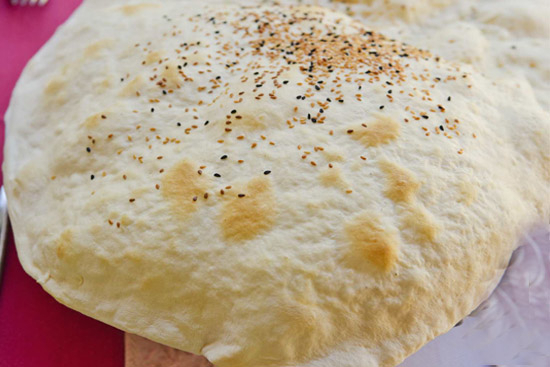
Serves: 4
Preparation time: 1 hour
Cooking time:10 minutes
3/4 cup plus 2 tablespoons water
3/4 cup milk
3/4 teaspoon active dry yeast
3/4 cup durum flour
3/4 cup bread flour
1/2 cup cake flour
1/2 cup plus 2 tablespoons whole-wheat flour
1/8 teaspoon salt
2 teaspoons molasses
1 tablespoon honey
1 tablespoon olive
oil Sesame seeds, poppy seeds, or salt, as needed
Parchment paper Preheat oven to 400 F.
Combine water, milk, and yeast into bowl of a heavy-duty mixer. Stir with a spoon to dissolve the yeast. Add flours, salt, molasses and honey. Attach dough hook and mix at low speed for 10 minutes.
Scrape dough into a large bowl and cover tightly with plastic wrap. Allow dough to rise for an hour at room temperature.
Turn dough out onto a floured surface and gently punch to remove most of the air.
Cover dough with a clean cloth and let rest for 15 minutes. Divide dough into 4 pieces. Stretch, or roll with a rolling pin, each piece to paper thin.
Brush each piece with olive oil, and sprinkle with seeds or salt. Place a piece of parchment paper on top of dough and roll seeds in with a rolling pin. Let rest for 15 minutes.
Place pieces on an ungreased cookie sheet. Bake until golden brown, about 7 to 10 minutes.
Cool and break into random pieces. Wrap tightly in plastic wrap.
Malaysian flatbread-roti canai 

Serves: 5
Preparation time:30 minutees
Cooking time:10 minutes
4 cups bread flour (520 g)
1 egg , room temperature
3 tablespoon unsalted butter (40 g), melted
1 tablespoon sweetened condensed milk or liquid honey
1 teaspoon salt
The Dough
• In a standing mixer bowl, add in flour, salt, egg, melted butter, condensed milk and water. Mix to incorporate and knead for 10 minutes. Leave to rest for 10 minutes and knead for another 5 minutes.
• Divide the dough into 10 small balls. Coat each ball generously with unsalted butter and place them in a container that has been generously buttered. Cover the container tightly with cling film and keep in the fridge overnight.
Shaping
• The next day. Spread some unsalted butter on the working surface. Take one ball and lightly flatten it. Press and push the dough with the heel of your palm to make it bigger. Stretch it as thin as possible, until you can almost see through it. Now and then spread some soften unsalted butter on it to help the stretching. Optional, lift up one edge of the dough and gently pull to stretch it even more.
• Scrape and push the upper end of the dough to the middle. Do the same to the lower end, forming a wrinkle thin log. Starting at one end of the log, roll it into a circle and tuck the other end inside. Leave aside for 10 minutes before cooking. Meanwhile you can continue with the rest of the balls.
Cooking
• Once ready to cook, take one rolled circle and flatten it into more or less 10-15 cm diameter. Heat some unsalted butter on a pan using medium heat. Place the flatten dough on the pan. Cook for several minutes and then flip. Continue cooking for some minutes more.
• This is important for a fluffy roti canai. Remove the cooked roti canai and place it on a working surface. Immediately yet carefully grab it using both of your hands and squeeze it to the center. We want to fluff it. You can see this part more clear in the video above.
• Keep the roti canai under a kitchen cloth to keep them warm. They're best eaten with dhal curry or any type of curry with some sambal. Enjoy!
Source of recipe: https://www.elmundoeats.com/homemade-roti-canai/
Malt bread with raisins 
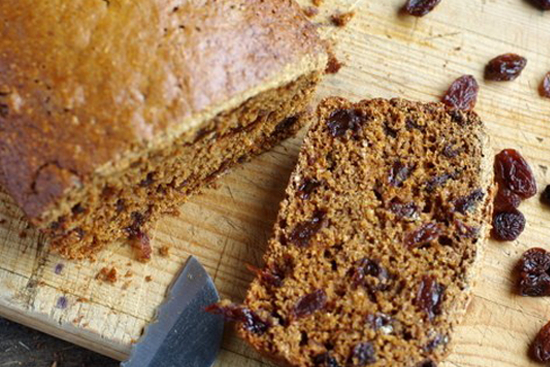
Serves: 4
Preparation time: 20 minutes
Cooking time:40 Minutes
1 Tablespoon (15 mL) Brown sugar
3 Tablespoon (45 mL) Malt extract
2 Tablespoons (30 mL) Molasses
25 Gram (1 oz) Butter
250 Milliliter (1 cup) Milk
100 Grammes (3 1/2 oz) Whole wheat flour
350 Grammes (plus extra for bench) Bread flour
Salt To Taste
14 Grammes (1 Tbsp) Active dry yeast
225 Grammes (1 1/2 cups) Seedless raisins
1. Place the sugar, malt extract, molasses, butter, and milk in a pot and heat gently until the butter has just melted.
2. Set aside to cool, below 95ºF.
Mix the flours, salt, yeast and raisins in a mixing bowl. Pour in the malt/milk mixture.
3. Mix thoroughly; the mixture will be soft and a little sticky. Turn the mixture onto a floured surface and knead gently for 5-6 minutes.
4. Divide the dough in two, and shape into a loaf. Place the shaped dough into two greased 450g/1lb loaf pans or loaf dishes.
5. Shape into the dishes so that the top is smooth and level.
6. Cover loosely with plastic wrap.
7. Let rise for a couple of hours, or until the dough has risen to the top of the dishes. Preheat your oven to 190ºC (375ºF).
8. Remove the plastic wrap and bake for 30-40 minutes.
9. The loaves are done when they reach an internal temperature of 195º.F. Cool on a wire rack.
Morning glory muffins 
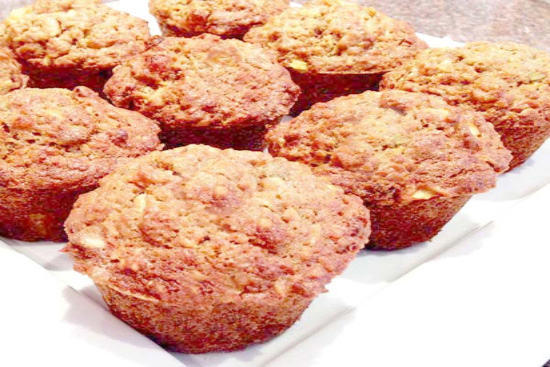
Serves: 12
Preparation time:20 minutes
Cooking time:30 minutes
2/3 cup raisins
2 cups Whole Wheat Flour, spooned and leveled
1 cup plus 2 tablespoons light brown sugar, packed
2 teaspoons baking soda
1 tablespoon ground cinnamon
1 teaspoon ground ginger
1/2 teaspoon salt
2 cups peeled and grated carrots
1 large tart apple, such as Granny Smith, peeled, cored and grated
1/2 cup shredded coconut, unsweetened
2/3 cup chopped walnuts
1/3 cup wheat germ
3 large eggs
2/3 cup vegetable oil
2 teaspoons vanilla extract
1/4 cup orange juice Preheat the oven to 375°F. Lightly grease a 12-cup muffin tin or line the 12-cup muffin tin with paper cups.
In a small bowl, cover the raisins with hot water. Set them aside to soak while you assemble the rest of the recipe.
In a large bowl, whisk together the flour, brown sugar, baking soda, cinnamon, ginger and salt.
Stir in the carrots, apple, coconut, walnuts, and wheat germ.
In a separate bowl, beat together the eggs, oil, vanilla, and orange juice. Add to the flour mixture, and stir until evenly moistened.
Drain the raisins, squeezing out any excess water with your hands, and stir them in.
Divide the batter among the wells of the prepared pan. They will be very full.
Bake the muffins for 25 to 28 minutes, until they're nicely domed and a cake tester inserted in the center of one of the inner muffins comes out clean.
Remove the muffins from the oven and let cool in the pan on a rack for about 5 minutes. Turn the muffins out onto the rack to cool completely. Cover and store at room temperature for several days, or freeze for longer storage.
Naan 
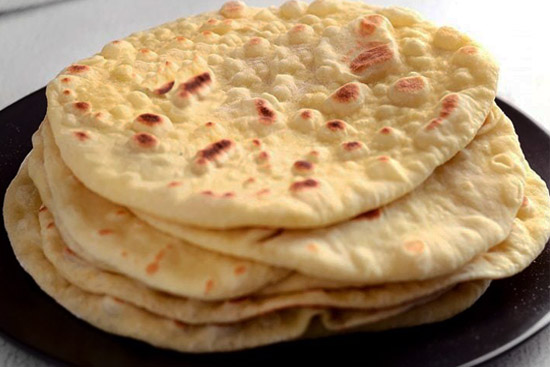
Serves: 4
Preparation time:40 minutes
Cooking time:10 minutes
1 1/4 cup all purpose flour (5.65 oz / 160 g)
1/2 teaspoon baking powder
1/3 teaspoon granulated sugar
1/2 teaspoon salt
3 tablespoons + 1 teaspoon milk (50 ml)
2 tablespoons butter (1 oz / 27 g)
1/4 cup plain whole milk yogurt (2 1/3 oz / 65 g), you can also substitute greek yogurt or even sour cream
Optional: melted butter for brushing (Butter-Naan), 2 cloves of garlic, cut lengthwise (Garlic-Naan)
1. Mix flour, baking powder, sugar and salt in a bowl.
2. In a small saucepan, heat milk together with butter (in small pieces), until butter has melted. You can also do this in a microwave. Let the milk cool down slightly.
3. In a big bowl add yogurt and stir in warm (not hot!) milk until smooth.
4. Gradually, add the dry ingredients and stir with a spoon, until the ingredients come together.
5. With your hands, knead to a smooth dough. It’s best to first knead the dough in the bowl and later transfer to a lightly floured surface and keep kneading. If the dough is still sticky, add a little more flour.
6. Let the dough rest for ½ hour on a lightly-floured surface and put the empty bowl upside-down on top of it. Alternatively, let it rest in the bowl, covered with a lid or cling wrap. The longer the dough rests, the softer it gets and the easier it will roll out.
7. Split dough into 4 equal parts (it's best to use a kitchen scale), shape each into a ball and roll out.
8. Rotate the dough-disk while rolling, and flip it over occasionally. Sprinkle with flour every now and then, so it will not stick to your rolling pin or surface. When finished, the Naan should have an oval shape, 6’’ x 9’’ large and about 1/8 inch thick.
9. Preheat skillet or pan to medium high heat – but don’t add any oil.
10. Pick up the Naan, remove excess flour by slapping the dough between your hands and put it into the pan. Cook until bubbles have formed on top and the bottom side gets lightly nicely browned. Then flip, and cook until done, about 1 minute.
11. Wrap the ready Naans in a kitchen towel or place on a plate and cover with a kitchen towel or aluminum foil keeping them warm while baking the rest. That will also make the Naans really soft.
12. For Butter-Naan, brush each flatbread with melted butter, for Garlic-Butter-Naan rub bread with garlic cloves first and then brush them with butter. Enjoy!
Onion braid 
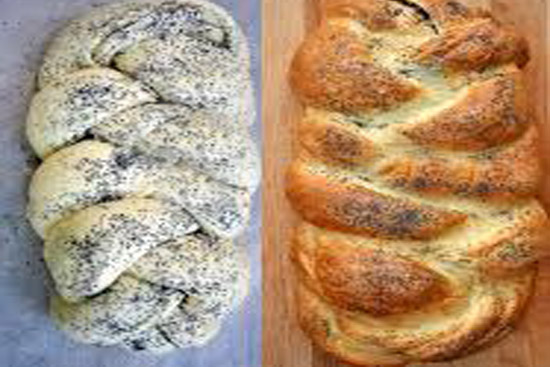
Serves: 8
Preparation time: 50 minutes
Cooking time:35 minutes
For dough:
4 cups flour
1/4 cup sugar
3/4 teaspoon salt
1 teaspoon instant dry yeast
1/2 cup milk
1/2 cup water
1/4 cup butter
1 egg
For filling:
1 cup finely chopped onion
1/4 cup butter
1 teaspoon grated parmesan cheese
1 teaspoon sesame seeds
1 teaspoon garlic salt
1 teaspoon paprika
Reserve 1 cup of flour. Mix remaining flour, sugar, salt, and yeast in a large bowl. Heat milk, water and butter until very warm (125 F/50 C).
Stir warm liquid into dry ingredients. Beat in egg. Mix in enough of the reserved flour to make a soft dough that does not stick to bowl. Turn out onto floured surface; knead until smooth and elastic, about 5 minutes. Cover; let rest 10 minutes.
Meanwhile, sauté onion in butter. Remove from heat and stir in remaining filling ingredients; set aside.
Roll dough into 18-by-12-inch rectangle. Cut evenly into three lengthwise strips 18 x 4-inch.
Evenly spread filling along center of strips. Fold each strip lengthwise and pinch edges together along 18-inch side to enclose filling. Braid strips together. Pinch ends to seal and tuck ends under loaf. Grease a baking sheet.
Place braid on sheet. Cover. Let rise in warm draft-free place until doubled in size, about 40 minutes.
Preheat oven to 350 degrees. Brush top with beaten egg white and sprinkle with more sesame seed, if desired. Bake 30 to 35 minutes or until done. Remove to wire rack to cool.
Parker house rolls 
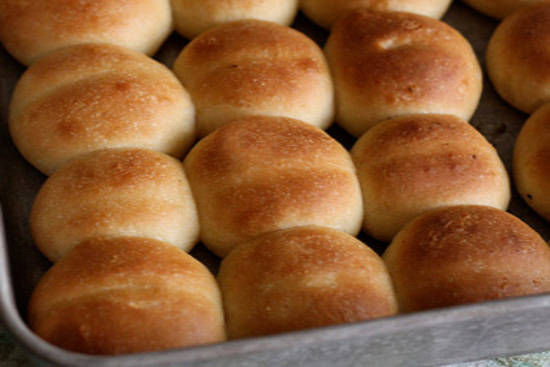
Serves: 20
Preparation time: 45 minutes
Cooking time:25 minutes
3 tablespoons warm water (105-110°F)
3 tablespoons sugar
1/4-oz package active dry yeast (2 1/2 teaspoons)
1 stick unsalted butter
1 cup whole milk
2 cups bread flour
1 1/2 teaspoons salt
1 1/2 to 2 cups all-purpose flour Stir together warm water, 1 tablespoon sugar, and yeast in a small bowl and let stand until foamy, about 5 minutes.
Melt 3/4 stick butter in a small saucepan. Add milk and heat to lukewarm. Stir together yeast mixture, remaining 2 tablespoons sugar, butter mixture, bread flour, and salt in a bowl with a wooden spoon until combined well, then stir in enough all-purpose flour to make a slightly sticky dough that forms a ball.
Butter a large bowl. Knead dough on a lightly floured surface, kneading in more all-purpose flour if dough is too sticky, 10 minutes, or until smooth and elastic but still slightly sticky. Form into a ball and put in buttered bowl. Turn to coat with butter, then let rise in bowl, covered with plastic wrap, in a warm place 1 hour, or until doubled in bulk.
Butter a 13- by 9-inch baking pan. Divide dough into 20 equal pieces and roll into balls. Arrange evenly in 4 rows of 5 in pan and let rise, covered loosely, in a warm place 45 minutes, or until almost doubled in bulk. Make a deep crease down center of each row of rolls using length of a floured chopstick or side of a ruler. Let rolls rise, covered loosely, 15 minutes.
Preheat oven to 375°F.
Melt remaining 2 tablespoons butter and cool slightly. Brush tops of rolls with butter and bake in middle of oven until golden, 20 to 25 minutes. Let rolls cool in pan on a rack 5 minutes. Turn out onto rack and cool to warm.
Pogne de romans 
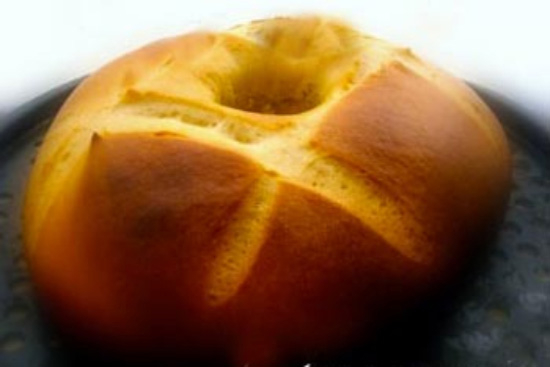
Serves: 14
Preparation time: 2 hours 30 minutes
Cooking time:40 minutes
For Starter:
2 teaspoons dry yeast
1/2 cup warm water (105-115 degrees F.)
1 cup flour
For dough:
6 cups flour
6 eggs, at room temperature
1/4 cup rum or brandy
1 cup sugar
2 teaspoons water
2 teaspoons salt
1/4 cup orange flower water (0r 4 teaspoons orange extract)
8 ounces soft butter
glaze:
1 egg
1 teaspoon milk Cut two 16 inch round parchment paper disks to fit under each pogne. Butter each disk. Place on baking sheet. In a small bowl, dissolve yeast in water.
Stir in flour to make a soft dough. Let dough rise in covered bowl at room temperature (70-75 F) to double in bulk. On a working surface, form a well with 1 1/2 cups flour. Break 4 eggs in center. Bring the flour and eggs together to form a mass.
Turn dough to the bowl of an electric mixer. Beat 2 to 3 minutes at medium speed.
Batter will be smooth and light golden yellow. Add, rum or brandy, sugar and 2 teaspoons water. salt and orange flower water and stir in.
Gradually add butter while mixing. When all the butter has been stirred in, add remaining eggs and blend well at medium speed. Knead the rest of flour, one cup at the time until dough is soft and elastic. Form dough into a ball. Return to the large bowl. Cover with plastic.
When the starter has developed, it is added to the larger ball of yellow dough. Place the yellow dough on the working surface and flatten. Spread the starter dough over it. Fold over the yellow dough to envelop the starter dough.
Work and knead together to form a smooth dough with no streaks of color remaining. Place dough in a clean bowl, cover with plastic wrap, and leave at room temperature until nearly doubled in volume. Turn dough onto work surface.
Divide into 2 pieces. Form each into a ball. Flatten the ball so the pogne is about 8 inches in diameter.
Press a thumb down in the center. With the fingers, open a hole about 4 inches across. Place pogne on the prepared paper disk on baking sheet. Repeat for second piece. Cover with wax paper and let rise at room temperature free of draft for about 21/2 hours. Brush with glaze. With a razor blade, make 3 connecting cuts on top of each pogne to form a triangle.
Bake at 350 degrees until crust is a deep glistening brown.
Quick and easy pancakes 
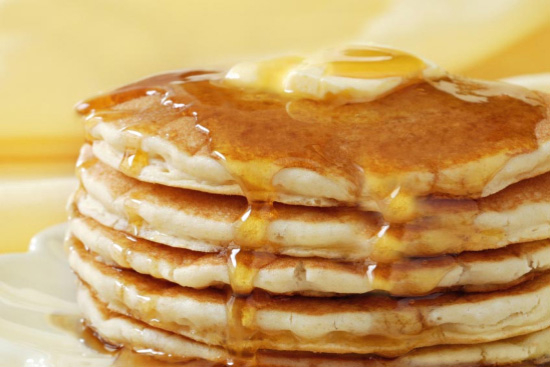
Serves: 6
Preparation time:10 minutes
Cooking time:20 minutes
For the instant Pancake mix:
28 ounces all-purpose flour (by weight)
1 tablespoon baking powder
1 1/2 teaspoons baking soda
1 tablespoon kosher salt
1 ounce light brown sugar
Quick and easy Pancakes:
10 ounces (by weight) instant pancake mix (above)
2 large eggs, separated and at room temperature
2 cups low-fat buttermilk at room temperature (plus another ounce to adjust consistency of final batter)
2 ounces unsalted butter, melted in a small saucepan and cooled
1 ounce unsalted butter, shortening or non-stick spray for the pan
8 ounces fresh fruit such as blueberries (optional) INSTANT PANCAKE MIX
Sift all ingredients together and store in an airtight container in the pantry for up to 3 months. Shake well before each use.
PANCAKES
Heat an electric griddle to 350 degrees F or set a heavy skillet or griddle over medium heat.
Heat the oven to the lowest possible temperate (not more than 200 degrees F).
Place the pancake mix in a large mixing bowl.
Whisk the egg whites and the buttermilk in a second bowl.
Whisk the egg yolks into the cooled melted butter.
Whisk the butter mixture completely into the buttermilk mixture.
Combine the wet team onto the dry instant pancake mix and quickly bring together with a large whisk. Do not over mix.
Ladle 1 ounce (by volume) of batter onto the griddle. Spread the batter out to a disk about 4 inches in diameter. Cook for 3 minutes, or until bubbles around the upside edge set. If you wish to integrate the fruit into the pancake itself, add it after the batter has been on the griddle for about 30 seconds.
Carefully flip with a wide spatula and cook for another 2 to 3 minutes, until golden brown on the bottom.
Serve immediately or keep warm in the oven by placing cakes on a half sheet pan and covering them with a tea towel for up to 20 minutes.
Roman maritozzi 

Serves: 6
Preparation time:40 minutes
Cooking time:15 minutes
The Resting Time for the dough: 3 hours
Total Time : about 4 hours 25 minutes
¼ cup + 3 tablespoons whole milk (lukewarm) (105 grams total)
1 teaspoon active dry yeast
2 cups +2½ tablespoons flour 00 (270 grams total)
3½ tablespoons fine sugar (divided)
1 large egg (room temperature)
4 tablespoons butter (softened)
½ tablespoon orange
½ teaspoon vanilla extract
¼ teaspoon salt (if you use unsalted butter then add ½ teaspoon of salt)
EGG WASH
1 large egg
1 tablespoon milk
SUGAR SYRUP
½ cup water
3-4 tablespoons granulated sugar
FOR THE CREAM FILLING
1 cup cream (whole, heavy or whipping cream at least 30% fat content)
1-2 tablespoons powdered sugar
In a small bowl mix together the milk and 1½ teaspoons of sugar, sprinkle the yeast on top and let sit for 10 minutes, then mix together.
In the stand mixer add the flour, zest, remaining sugar, salt, egg, vanilla and yeast mixture, knead on low speed then increase the speed and knead for up to 7 minutes.
Add the butter and knead again for approximately 10-15 minutes, until the dough stops sticking to the side of the bowl and is soft, smooth and elastic.
Scrape the dough into a lightly buttered bowl to rise in a warm draft free area for approximately 2 hours or until doubled in bulk.
Transfer the dough to a lightly floured flat surface, divide into 6 parts and shape into a slightly oval shape. Place the buns on a parchment paper lined baked sheet, cover and let rise in a warm draft free area until doubled, approximately 1½ hours.
Pre-heat the oven to 350F/180C.
Brush the buns with the egg wash and bake for 18-20 minutes or until golden brown and baked through. Remove from the oven, move immediately to a wire rack to cool completely.
Brush the completely cooled buns with the sugar syrup, cut each bun on a slight angle be careful not to cut all the way through, fill the open area with whipped cream.
Dust with powdered sugar and serve immediately. Enjoy!
FOR THE EGG WASH
In a small bowl, beat together the egg and milk until combined well.
FOR THE CREAM FILLING
In a large bowl whip the cream until soft peaks appear then add the powdered sugar and continue to beat until thick peaks appear.
Notes
The dough can also be left to rise overnight in the fridge.
Storage
Once the maritozzi are filled with cream, they should be served and eaten immediately. Plan on making them and enjoying them the same day!
Rye bread rugbrod 
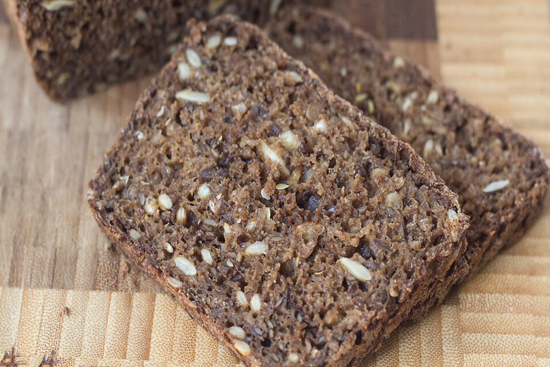
Serves: 8
Preparation time:1 hour
Cooking time:1 hour
This is a recipe for probably the most famous type of bread in Denmark. Also known as Ruisleipa in Finland.
The recipe is based on a sour dough which takes about 5 days to make. The sour dough can be kept 'alive' and then it is faster to make the a rye bread.
3/4 cup cracked rye kernels
3/4 cup cracked wheat
3/4 cup flax seed/linseeds
3/4 cup sunflower seeds
1 tbsp malt syrup (or dark syrup)
1 1/2 cups Traditional
sour dough
3 1/4 cups water
1 1/2 cups all-purpose flour
1 1/2 cups rye flour
1 tbsp salt
2 tbsp gravy browning (can be omitted) In a large bowl; Add the cracked rye kernels, cracked wheat, flax seeds, sunflower seeds, water, malt syrup and the sour dough. Let it all soak for minimum 8 hours. This can with advantage be done in the evening, so that you can continue the morning after.
After about 8 hours; add the rest of the ingredients and let the rye bread dough rise for about 1.5 hours.
Divide the dough into two portions and pour it into two normal bread pans. Cover the bread pans with some plastic wrap (or a damp dishtowel). Let the dough rise for about 1-2 hours or until the bread pan is full of dough.
Bake the rye breads at 180 C (360 F) for about 1 hour.
When done; remove the breads for the bread pans and let them cool off. When the breads are cooled off; keep them in an air tight container or a plastic bag.
Skyr bagels 
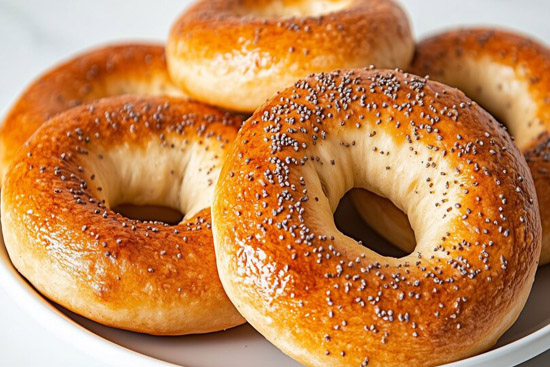
Serves: 5
Preparation time:15 minutes
Cooking time:30 minutes
450 grams of skyr
1.75 cups of all-purpose flour or half and half with oat flour
2 teaspoons of baking powder
1.5 teaspoons of salt Transfer the skyr into a bowl.
Sift the flour and baking powder.
Add the salt.
Mix with a spatula first, then knead by hand.
You can transfer the dough to a board lightly dusted with flour.
Divide the dough into five parts.
Preheat the oven to 170°C, fan setting.
Roll each piece and shape into a bagel.
Place on a baking sheet lined with parchment paper, with the seam facing down.
Optionally sprinkle with toppings; you can brush with a bit of egg white beforehand.
Put in the oven and bake for about 30 minutes until golden brown.
Note: Skyr vs. Greek Yogurt
Despite their similar creamy and thick textures, Greek yogurt and skyr are crafted with nuanced distinctions. Skyr, traditionally made from skim milk, boasts a lower fat content compared to Greek yogurt, which often utilizes whole milk. While both undergo straining, skyr typically endures a more extensive straining process, with the addition of rennet, an enzyme, yielding a thicker consistency. Additionally, variations in bacterial cultures used during fermentation contribute to subtle differences in taste and texture between the two yogurts.
Spiced pita chips 
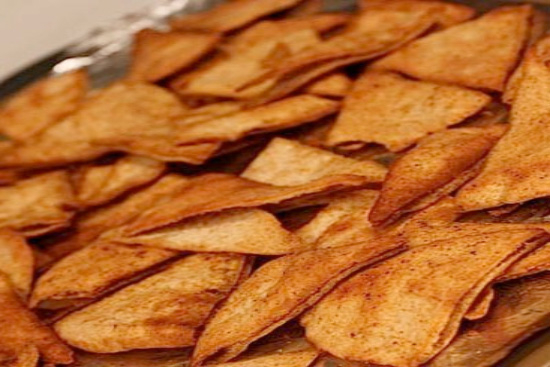
Serves: 10
Preparation time: 10 minutes
Cooking time:15 minutes
The chips will keep in an airtight container at room temperature for about 3 days.
1/4 cup olive oil
2 tsp. ground cumin
1 tsp. ground coriander
1/2 tsp. cayenne pepper
1 tsp. garlic powder
1/2 tsp. freshly ground black pepper
1/2 tsp. salt
6 whole-wheat pita breads, cut into 8 to 10 wedges each
Heat the oven to 375°F.
Combine the oil and spices in a large bowl. Add the pita wedges and toss to coat. Spread the wedges in a single layer on two baking sheets and bake, tossing once, until the pitas are brown and crisp, about 15 minutes. Let cool completely before serving.
Spicy cheese corn bread 

Serves: 8
Preparation time: 15 minutes
Cooking time:20 minutes
1 cup flour
1 cup cornmeal
1/4 pound shredded cheddar cheese
1 teaspoon finely chopped jalapeno
1 teaspoon baking powder
1 teaspoon sugar
1/2 teaspoon salt
1 cup milk
1 egg
2 teaspoons melted butter Preheat oven to 400 degrees.
In a large bowl combine the flour, cornmeal, cheese, jalapeno, baking powder, sugar and salt.
In a small bowl, whisk together the milk, egg and butter. Add milk mix to the dry ingredients and stir just until moistened.
Pour into a greased 8-inch square pan and bake for 18 to 20 minutes.
Streusel pumpkin bread 
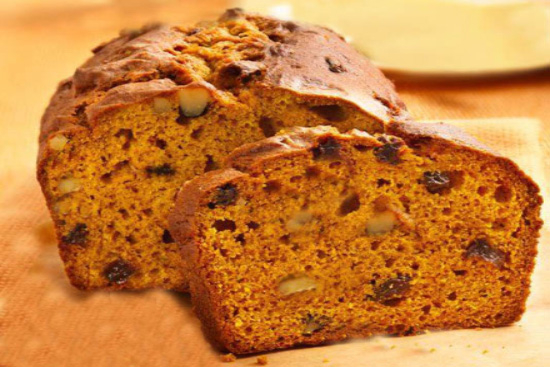
Serves: 16
Preparation time: 20 minutes
Cooking time:1 hour
1 1/2 cups sugar
1/2 cup oil
3 ounces water
2 eggs
1 cup canned pumpkin
1 3/4 cups flour
1 teaspoon baking soda
1/2 teaspoon salt
1/2 teaspoon cinnamon
1/2 teaspoon nutmeg
1/4 teaspoon cloves
1/4 cup chopped walnuts
1/4 cup raisins
TOPPING:
1/4 cup firmly packed brown sugar
1/4 cup finely chopped nuts
2 tablespoons flour
1/2 teaspoon cinnamon
2 tablespoons butter, softened. Preheat oven to 350 degrees. Grease and flour bottom only of one 9x5 inch loaf pan. In a large bowl, combine sugar, oil, water, eggs and pumpkin; beat 1minute at low speed. Add flour, soda, salt, cinnamon, nutmeg and cloves; blend at low speed until moistened then beat a minute at medium speed. Stir in nuts and raisins. Pour into prepared pan.
In small bowl, combine all topping ingredients until crumbly; sprinkle over batter. Bake for about one hour. Cool 5 minutes; remove from pan.
Cool completely on wire rack.
Whole grain brown soda bread 
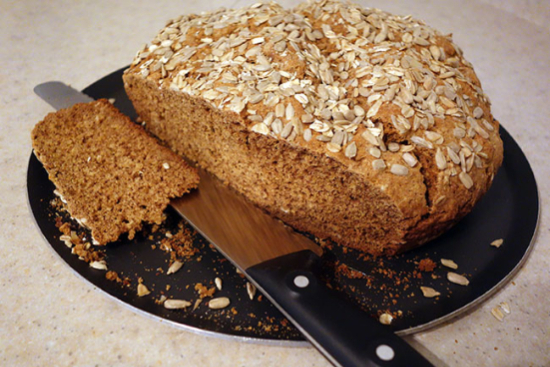
Serves: 12
Preparation time:15 minutes
Cooking time:25 minutes
There’s no yeast involved and no rising time, so this is a great last minute recipe.
3 1/4 cups (400 grams) whole wheat flour
1/2 cup (45 grams) rolled or traditional oats
1/4 cup (.6dl) oat bran or more oats
1 teaspoon salt
1 teaspoon baking powder
1/2 teaspoon baking soda
1 egg
2 tablespoons (44 grams) molasses
1 1/2 cups (355ml) buttermilk
1/3 cup (76 grams) melted butter
To top the loaf:
1 tablespoon (14 grams) butter
2 tablespoons oat bran or oats Preheat the oven to 375°F (190°C) and butter a 9" cast iron skillet or a 9" cake pan that has 2" sides.
Combine all the dry ingredients in a large bowl (flour through baking soda) and set this bowl aside.
In a medium bowl, mix together the remaining ingredients (egg through 1/3 cup melted butter). Add this to the dry mixture and stir. It will be sticky but you don't need to add more flour and you don't not need to knead the dough.
Scoop the dough into the prepared skillet or pan.
Brush the top with the tablespoon of melted butter and using a bread knife, cut an X, about 3/4" deep, into the loaf. Sprinkle the two tablespoons of oat bran or oats over the loaf.
Bake for 20 - 25 minutes or until a toothpick inserted in the middle comes out clean. Let the bread cool in the pan for about 5 minutes and then remove the bread and let it cool on a cooling rack until ready to serve. Best when served warm!
Whole grain soda bread 
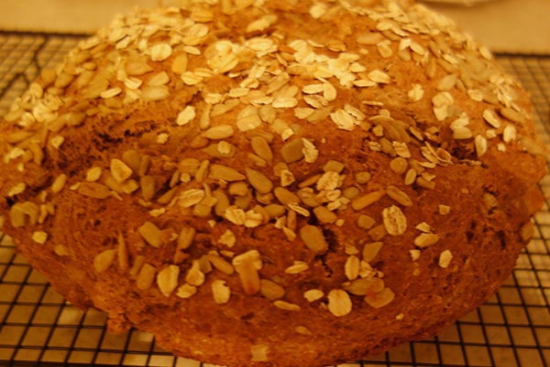
Serves: 8
Preparation time:20 minutes
Cooking time:1 hour
1/4 cup millet flour
1/4 cup quinoa flour
1/4 cup amaranth flour
1 cup old-fashioned oats, plus 1 Tbsp for topping
2 1/4 cups buttermilk, divided, plus more for brushing
1 Tbsp. vegetable oil, plus more for pan
4 cups whole wheat flour
2 tablespoons ground flaxseed
2 teaspoons salt
2 teaspoons baking soda
1/4 cup sunflower seeds, plus 1 Tbsp for topping
4 tablespoons unsalted butter, softened
3 tablespoons molasses
1. Mix millet, quinoa, amaranth, 1 cup oats, 1 cup buttermilk, and 1/2 cup water in a small bowl. Allow the sticky mixture to rest 30 minutes.
2. Meanwhile, preheat oven to 350°F. Lightly oil an 8"-diameter cast-iron skillet or cake pan.
In a large mixing bowl, mix whole wheat flour, ground flaxseed, salt, baking soda, and 1/4 cup sunflower seeds, soft butter, molasses, 1 1/4 cups buttermilk, remaining 1 Tbsp. oil AND the prepared oat mixture. Mix with a wooden spoon until dough is smooth, homogenous, and still slightly sticky.
3. Form dough into a ball and place in prepared pan. Brush with buttermilk; top with more oats and sunflower seeds. Cut a large X into the top and bake until golden brown and an instant-read thermometer inserted into the center of loaf registers 190°F, about 1 hour or longer. Let cool in pan.
whole wheat irish soda bread with bulgur 
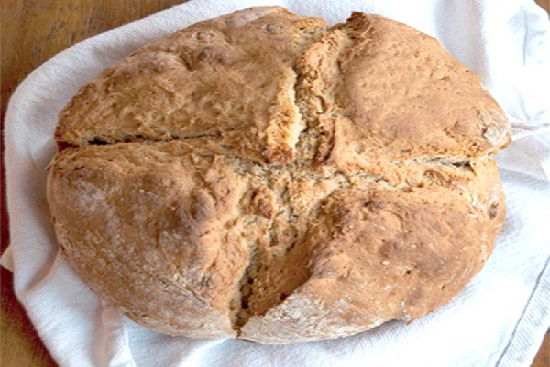
Serves: 12
Preparation time:30 minutes
Cooking time:1 hour
120 grams (about 3/4 cup) medium (#2) bulgur
1 cup boiling water
460 grams (about 3 2/3 cups) whole wheat flour
8 grams baking soda (1 1/2 teaspoons)
10 grams salt (about 1 1/2 teaspoons)
2 cups buttermilk (more as needed) 1. Place the bulgur in a bowl and pour on 1 cup boiling water, or enough to cover the bulgur by about 1/2 inch. Cover the bowl and allow the bulgur to sit for 30 minutes, until all the water has been absorbed and the grains are tender.
2. Meanwhile preheat the oven to 450 degrees and line a 9 inches round cast iron pan or a baking sheet with parchment.
3. Place the flour in a large, wide bowl and sift in the baking soda and salt. Mix in with your hands or with a wide spatula. Make a well in the middle of the flour and pour in the buttermilk. Add the bulgur to the well, then mix in the flour from the sides of the bowl to the center using a wide rubber spatula, a wide wooden spoon or your hands, turning the bowl and sweeping the flour from the sides into the buttermilk. Mix until the bulgur and buttermilk have been incorporated into the flour, then scrape out onto a lightly floured work surface. The dough should be soft and a bit sticky. Flour your hands so it won’t stick to them.
4. Gently knead the dough, only enough to shape it into a ball, then with floured hands gently pat it down to a 2-inch high round, about 9 inches in diameter. Place it on the parchment-lined cast-iron pan or baking sheet and cut a 1/2-inch deep cross across the top.
5. Place in the oven and bake 20 minutes at 450 degrees. Turn down the heat to 375 degrees and bake for another 15 to 20 minutes, until the loaf responds with a hollow sound when tapped on the bottom. Remove from the oven, wrap loosely in a cloth or kitchen towel, and cool on a rack.
conversion of liquids
Weights
Temperatures
Measures of non liquid ingredients
Non-liquid ingredients in volume converted
|
|||||||
|---|---|---|---|---|---|---|---|
Ingredient |
1 cup |
3/4 cup |
2/3 cup |
1/2 cup |
1/3 cup |
1/4 cup |
2 tablespoons |
| All-purpose wheat flour | 120 g | 90 g | 80 g | 60 g | 40 g | 30 g | 15 g |
| All-purpose sifted wheat flour | 110 g | 80 g | 70 g | 55 g | 35 g | 27 g | 13 g |
| White sugar | 200 g | 150 g | 130 g | 100 g | 65 g | 50 g | 25 g |
| Powdered sugar/Icing sugar | 100 g | 75 g | 70 g | 50 g | 35 g | 25 g | 13 g |
| Brown sugar normally packed | 180 g | 135 g | 120 g | 90 g | 60 g | 45 g | 23 g |
| Corn flour | 160 g | 120 g | 100 g | 80 g | 50 g | 40 g | 20 g |
| Cornstarch | 120 g | 90 g | 80 g | 60 g | 40 g | 30 g | 15 g |
| Rice (not-cooked) | 190 g | 140 g | 125 g | 95 g | 65 g | 48 g | 24 g |
| Macaroni (uncooked) | 140 g | 100 g | 90 g | 70 g | 45 g | 35 g | 17 g |
| Couscous (uncooked) | 180 g | 135 g | 120 g | 90 g | 60 g | 45 g | 22 g |
| Quick oatmeal (uncooked) | 90 g | 65 g | 60 g | 45 g | 30 g | 22 g | 11 g |
| Table salt | 300 g | 230 g | 200 g | 150 g | 100 g | 75 g | 40 g |
| Butter / Margarine | 240 g | 180 g | 160 g | 120 g | 80 g | 60 g | 30 g |
| Shortening | 190 g | 140 g | 125 g | 95 g | 65 g | 48 g | 24 g |
| Fruits and légumes chopped | 150 g | 110 g | 100 g | 75 g | 50 g | 40 g | 20 g |
| chopped walnuts | 150 g | 110 g | 100 g | 75 g | 50 g | 40 g | 20 g |
| Nuts /ground almonds | 120 g | 90 g | 80 g | 60 g | 40 g | 30 g | 15 g |
| Fresh bread crumbs (not packed) | 60 g | 45 g | 40 g | 30 g | 20 g | 15 g | 8 g |
| Dry bread crumbs | 150 g | 110 g | 100 g | 75 g | 50 g | 40 g | 20 g |
| Parmesan grated | 90 g | 65 g | 60 g | 45 g | 30 g | 22 g | 11 g |
| Chocolate chips | 150 g | 110 g | 100 g | 75 g | 50 g | 38 g | 19 g |
48 Recipes




